
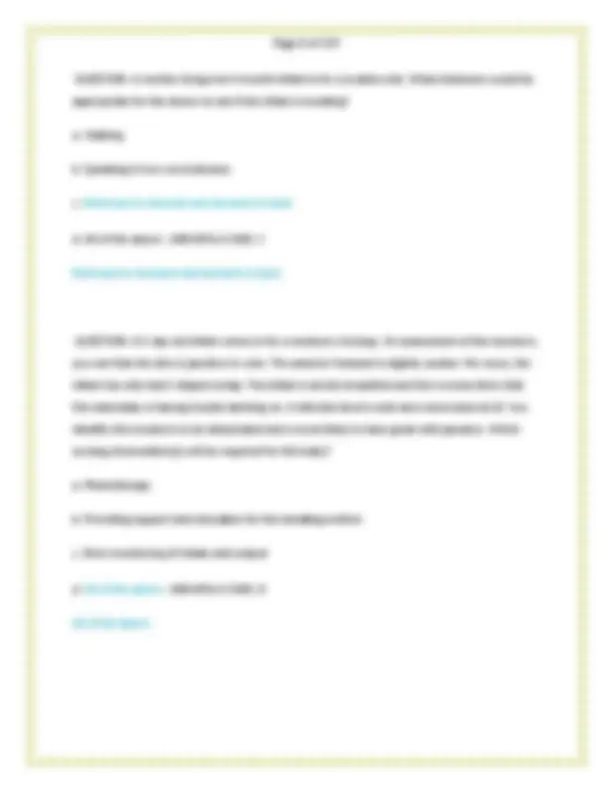
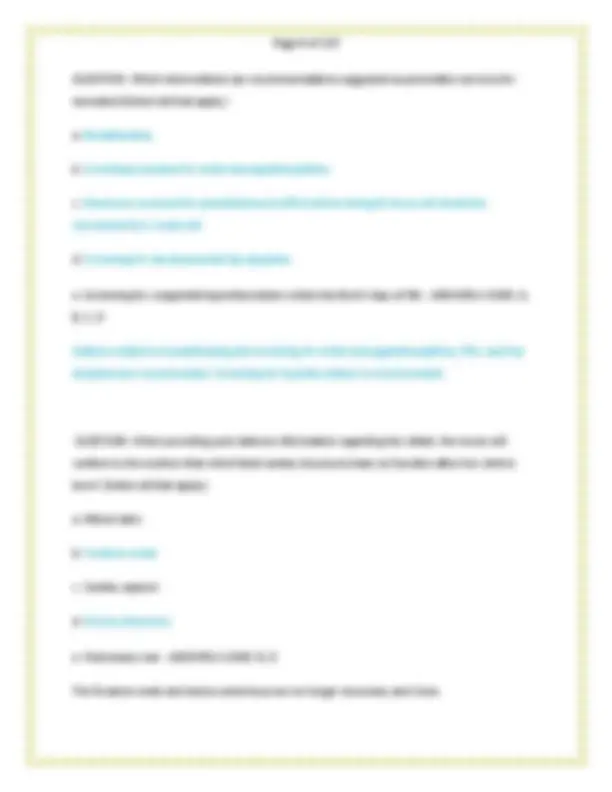
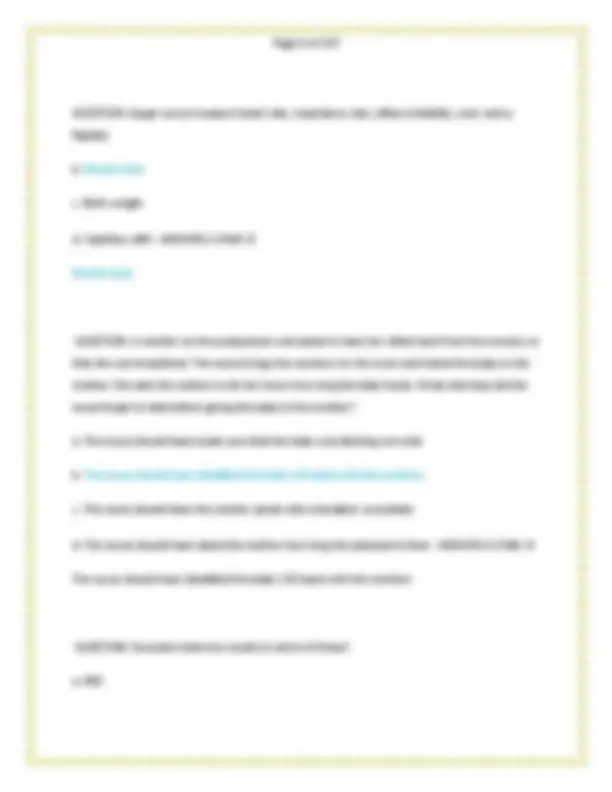
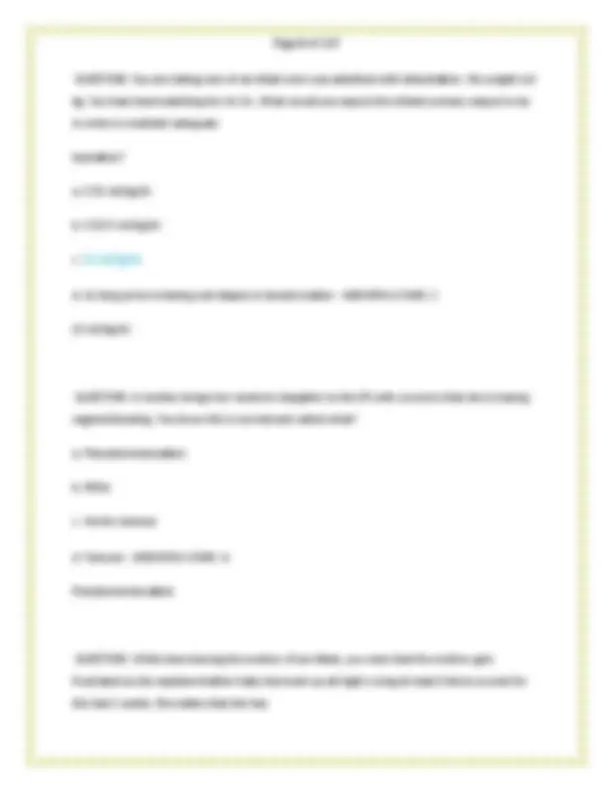
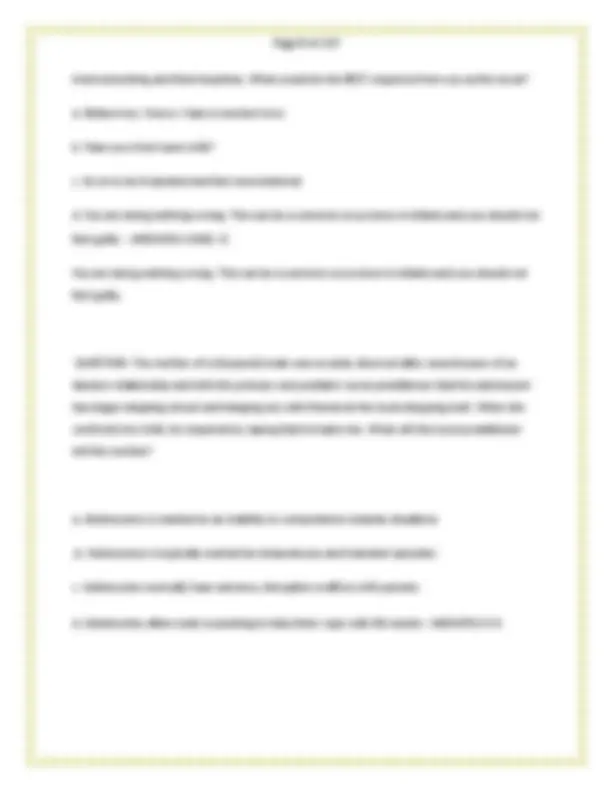
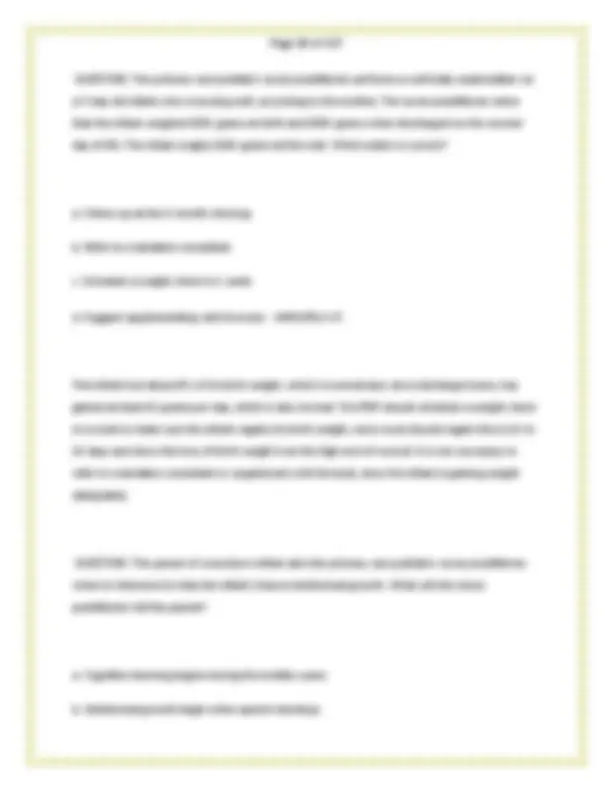
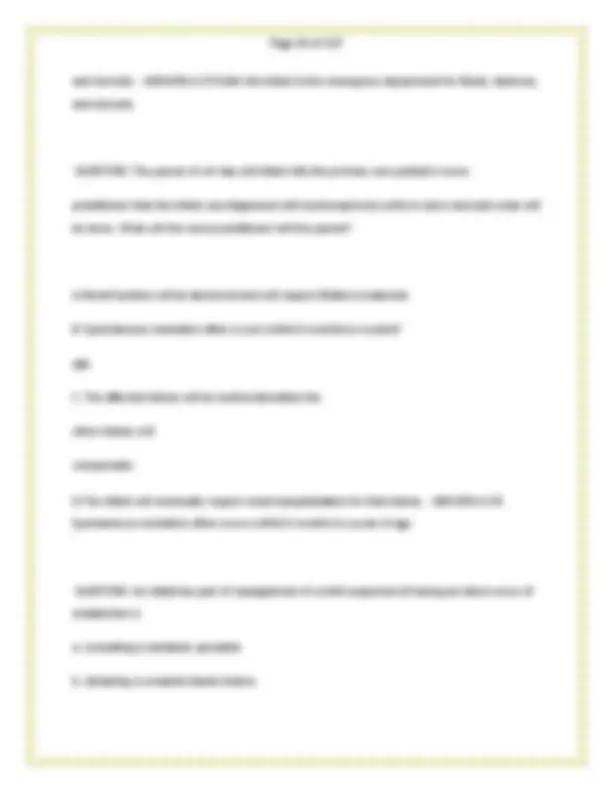
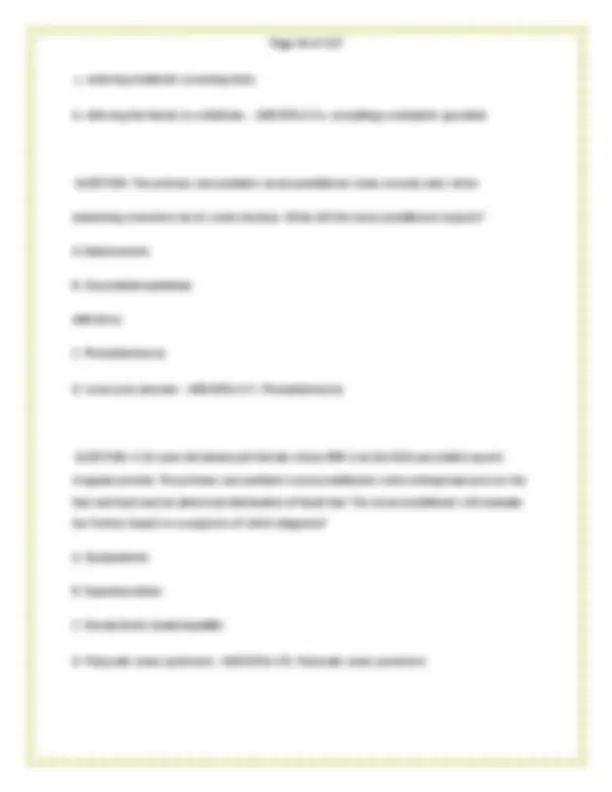
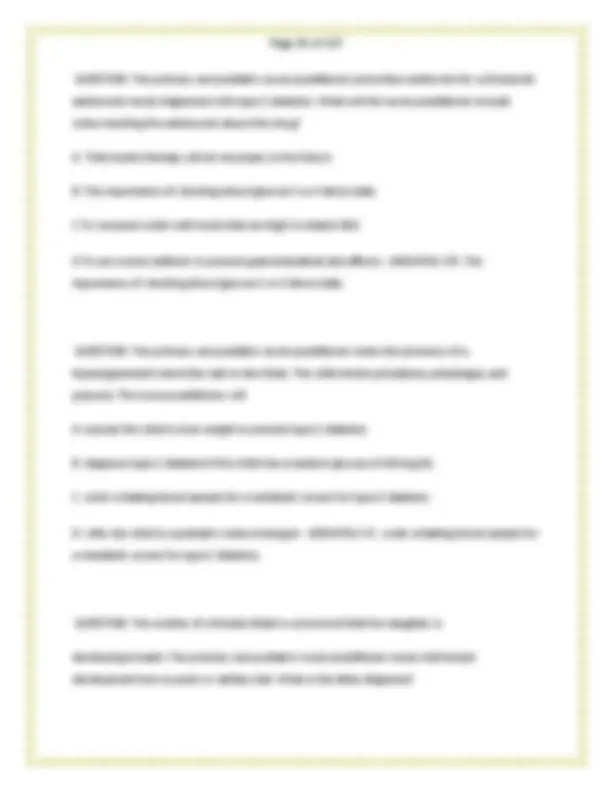
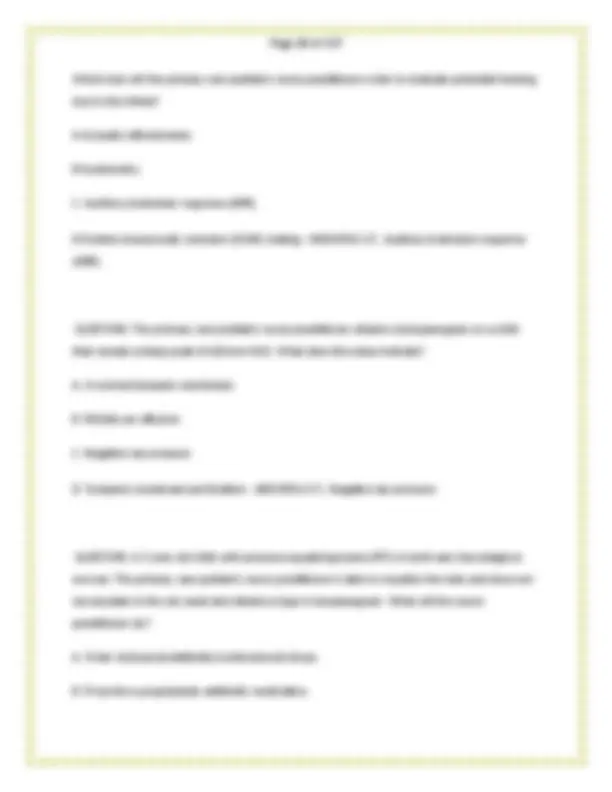
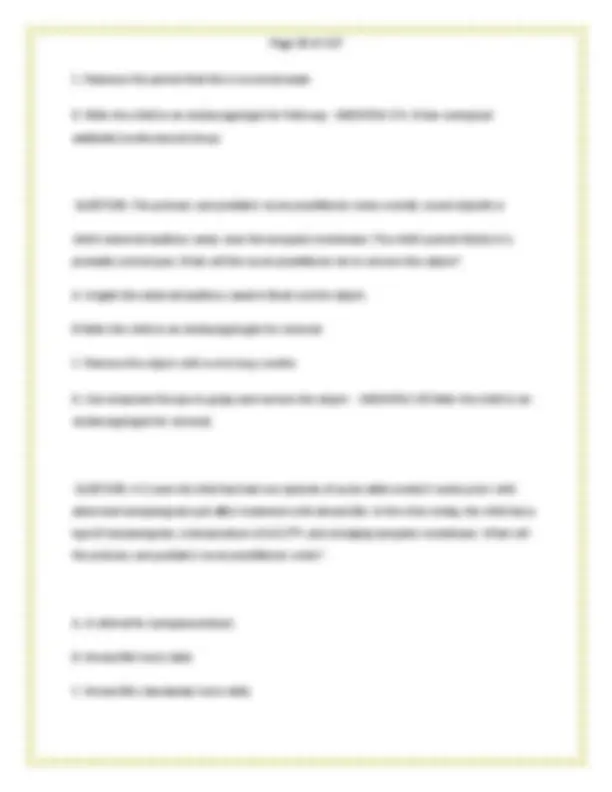
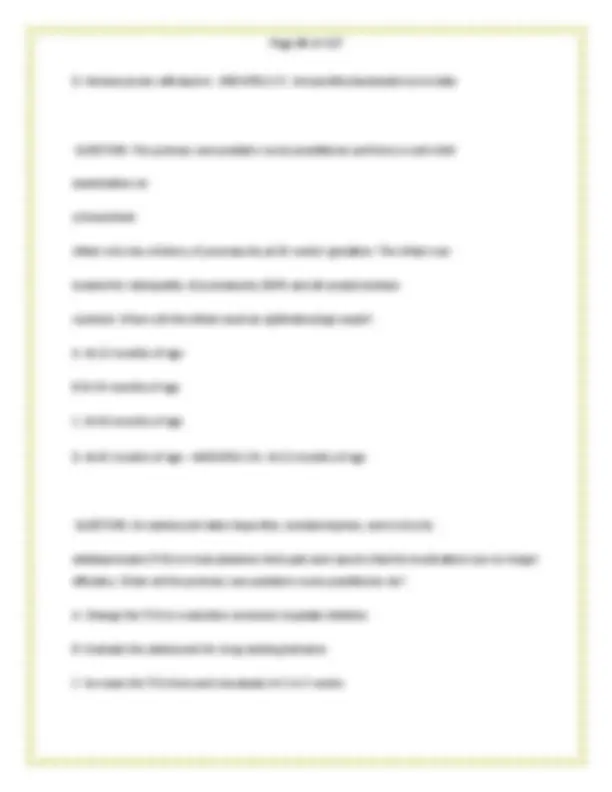
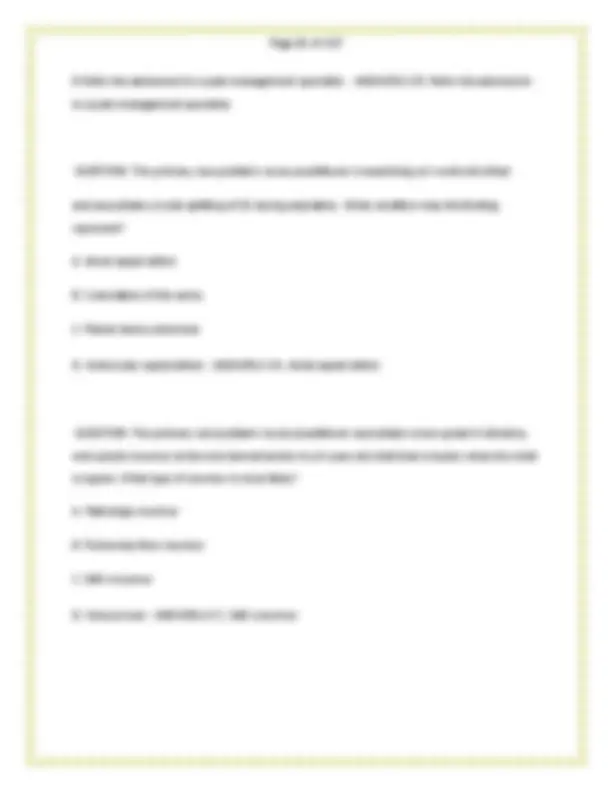
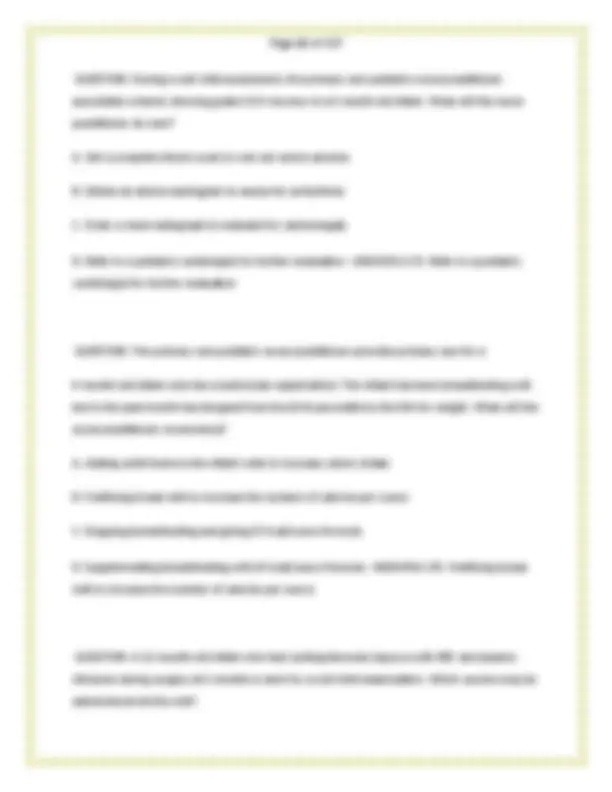
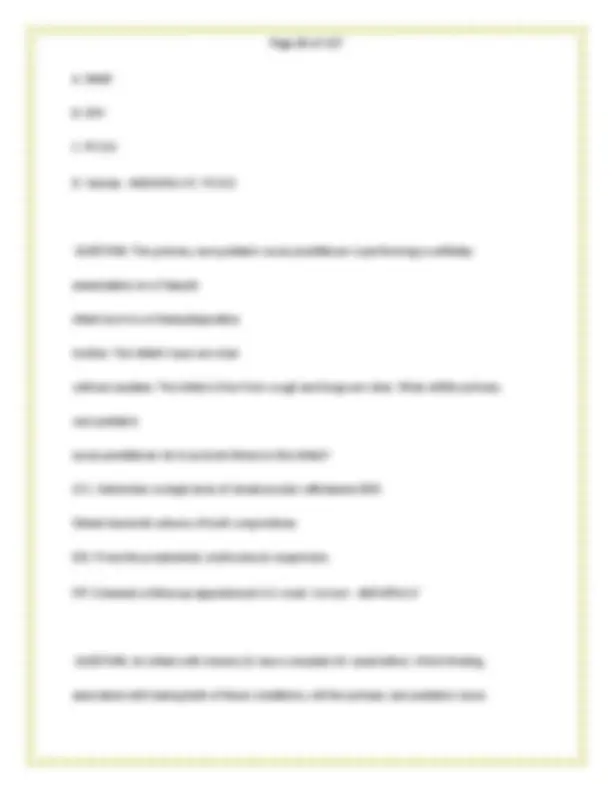

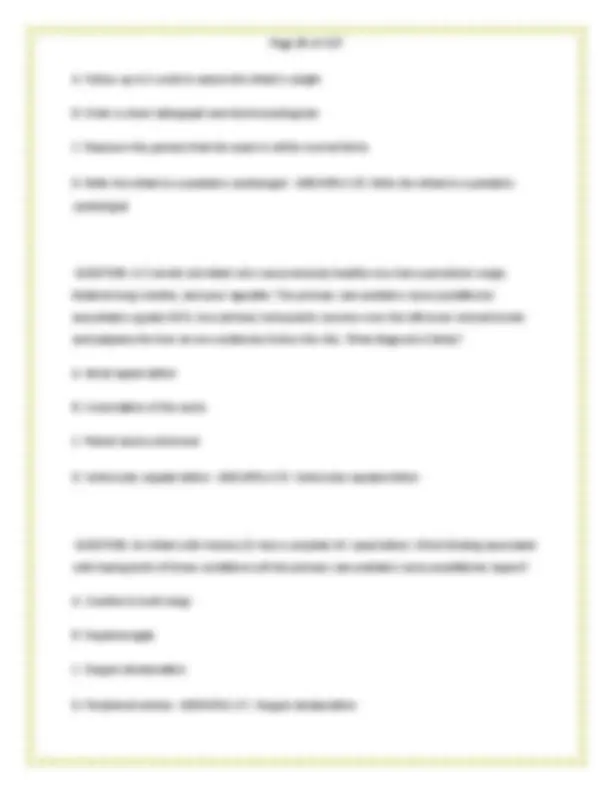
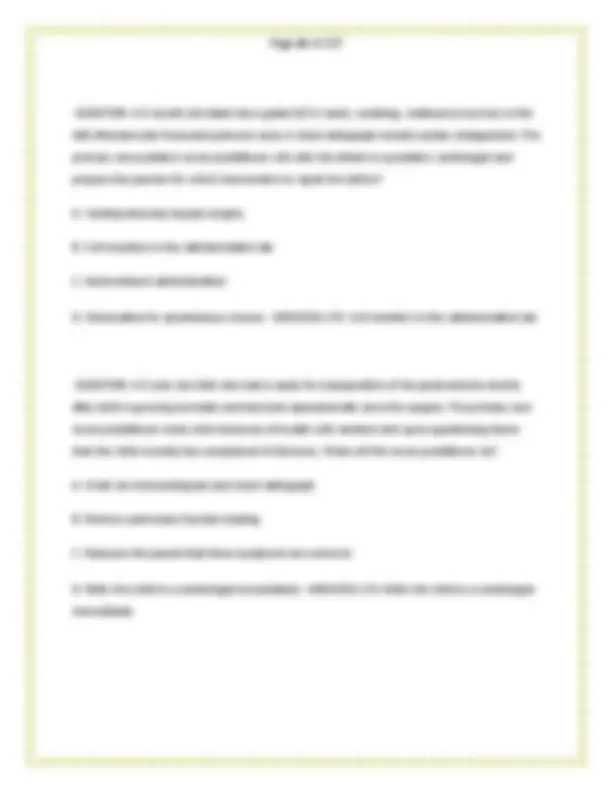
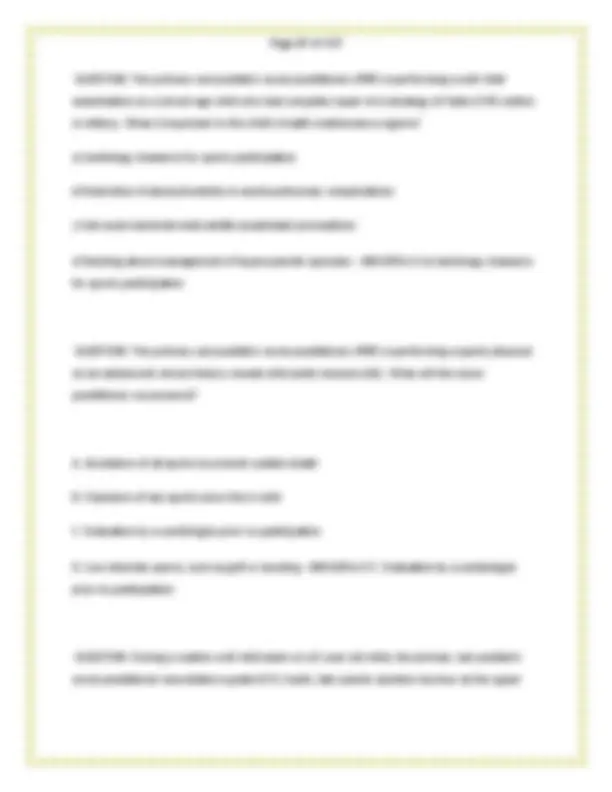
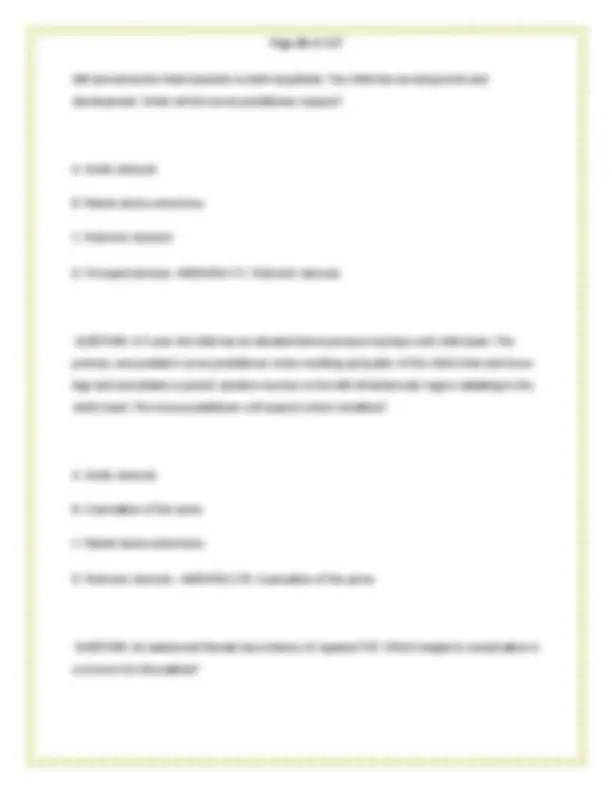
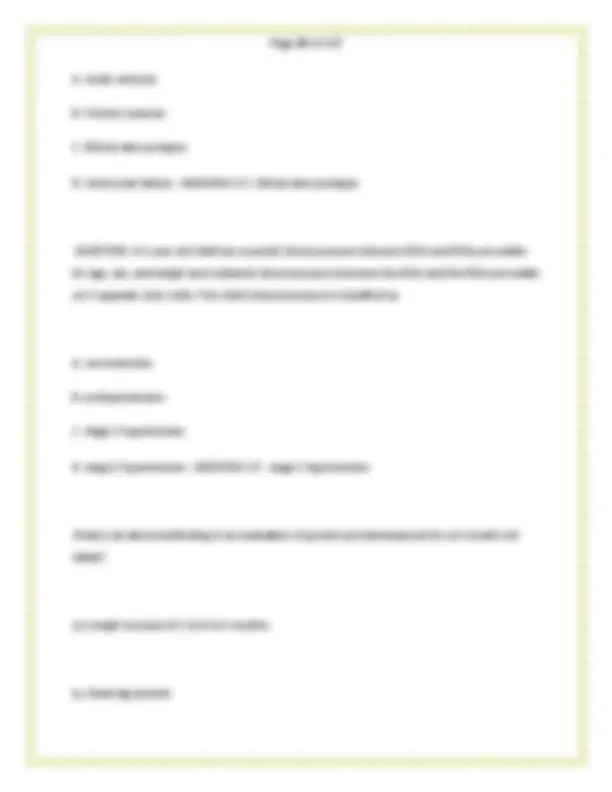
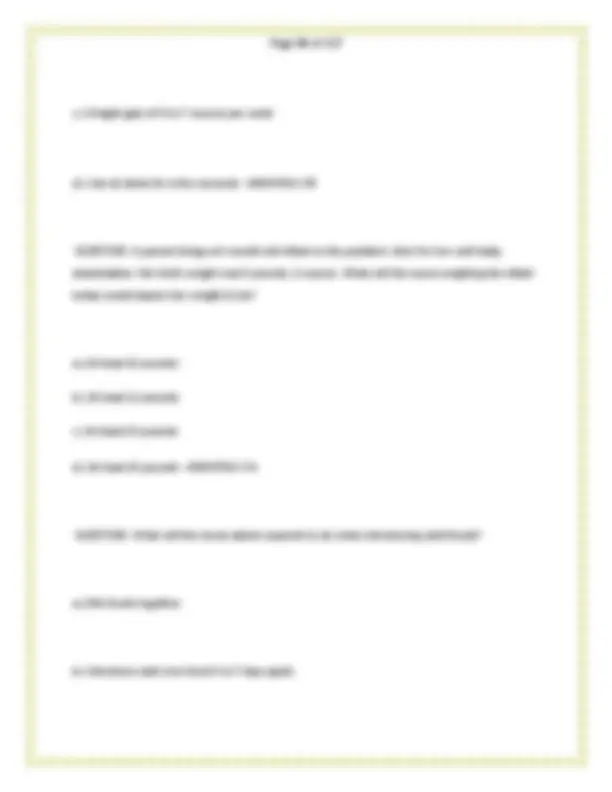
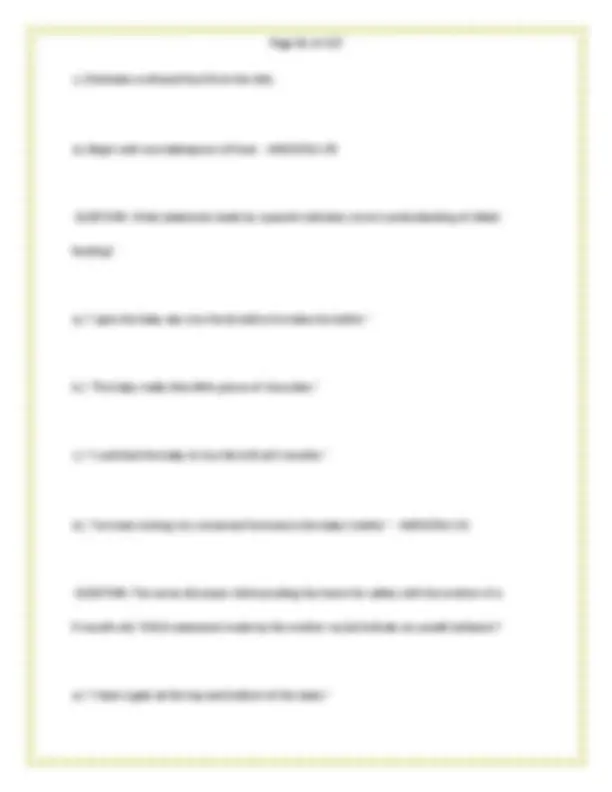
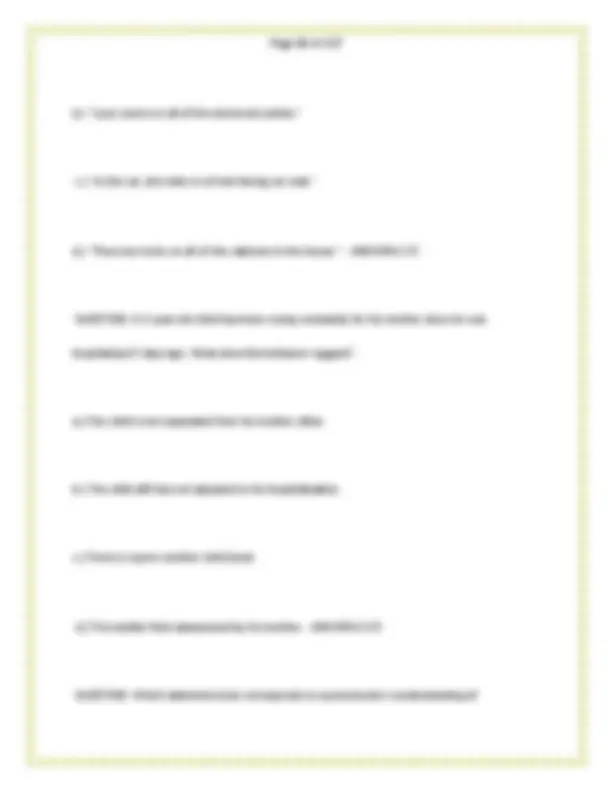
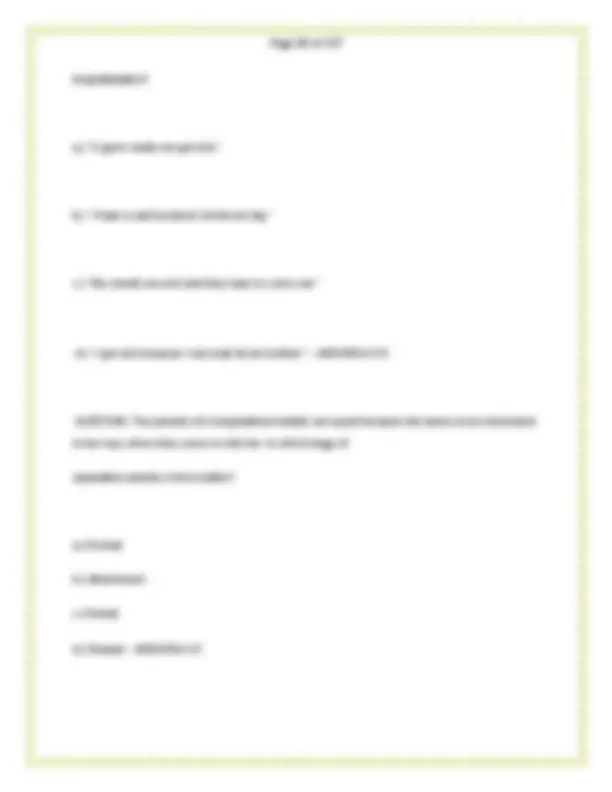
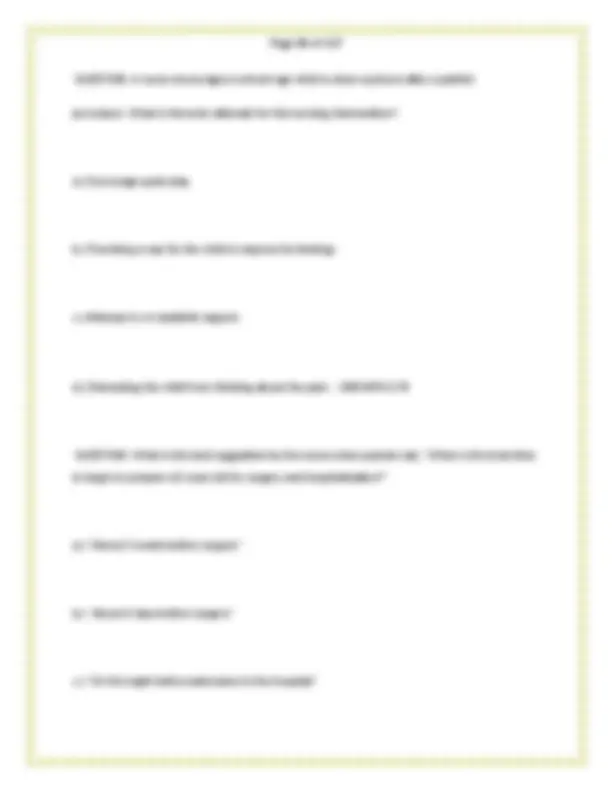
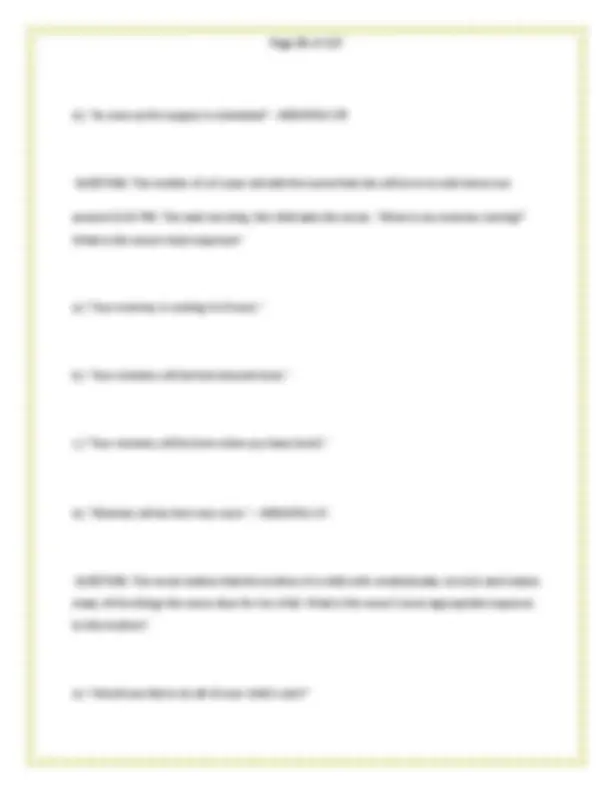
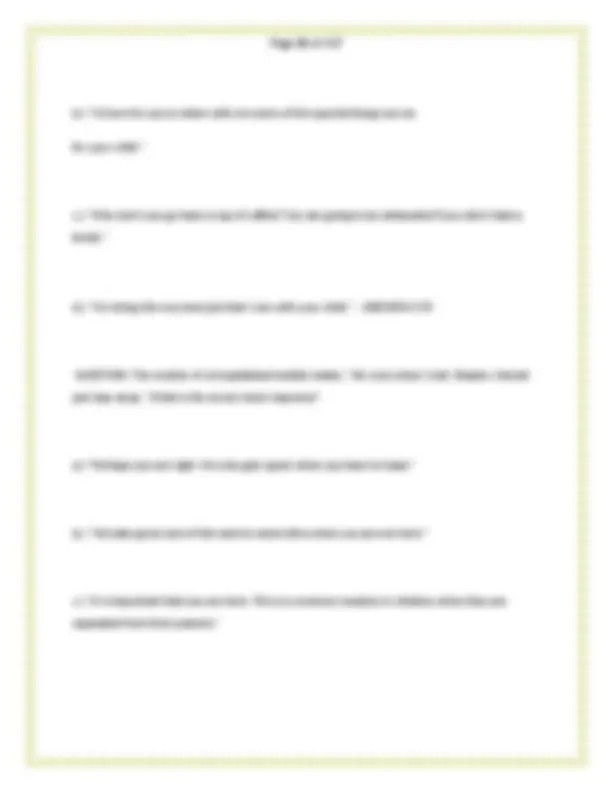
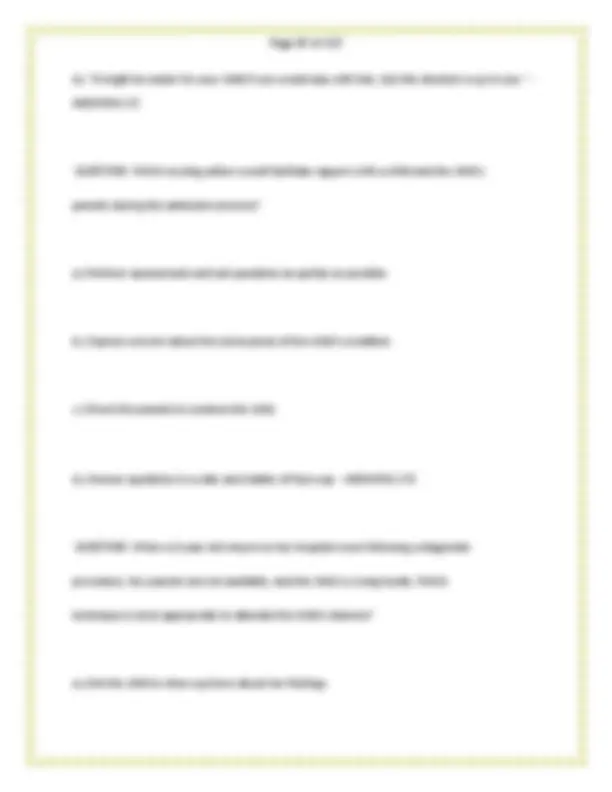
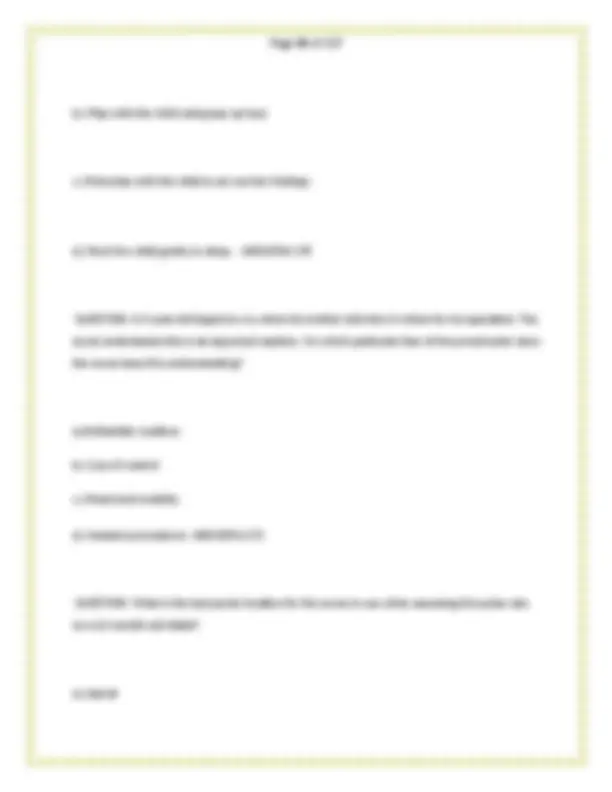
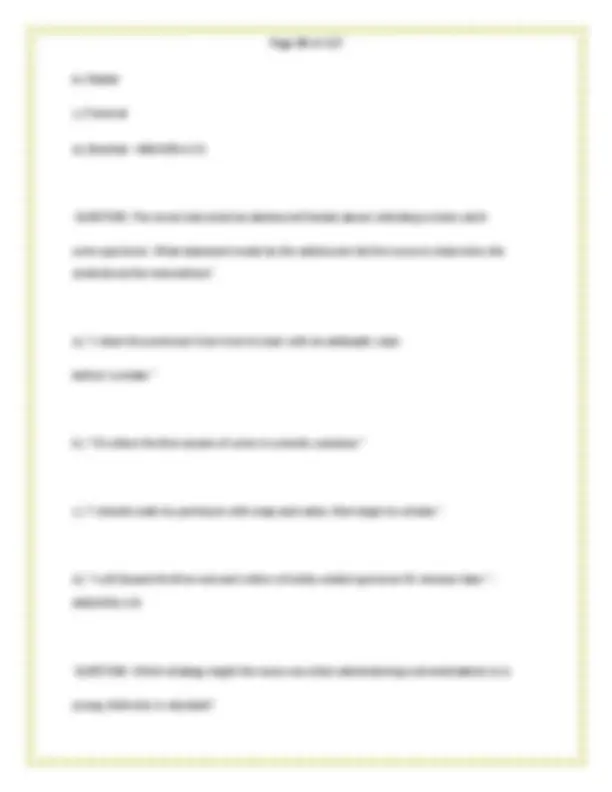
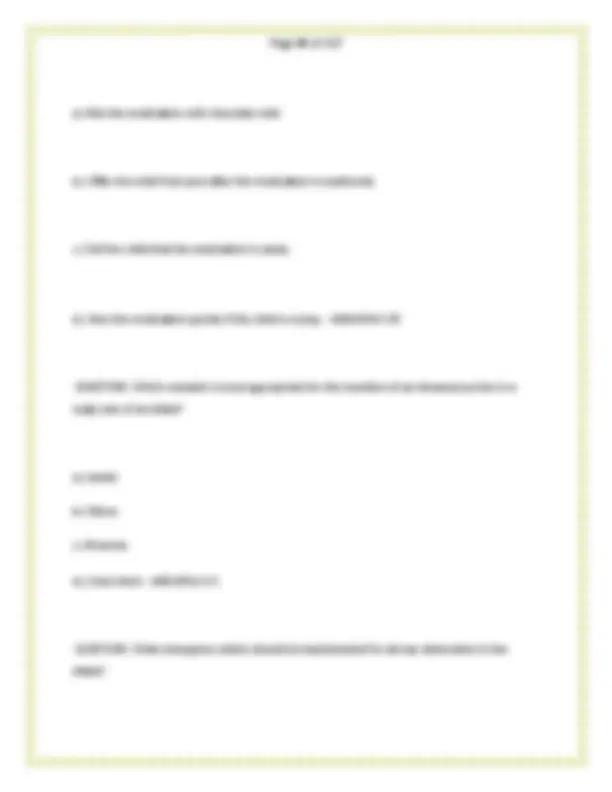
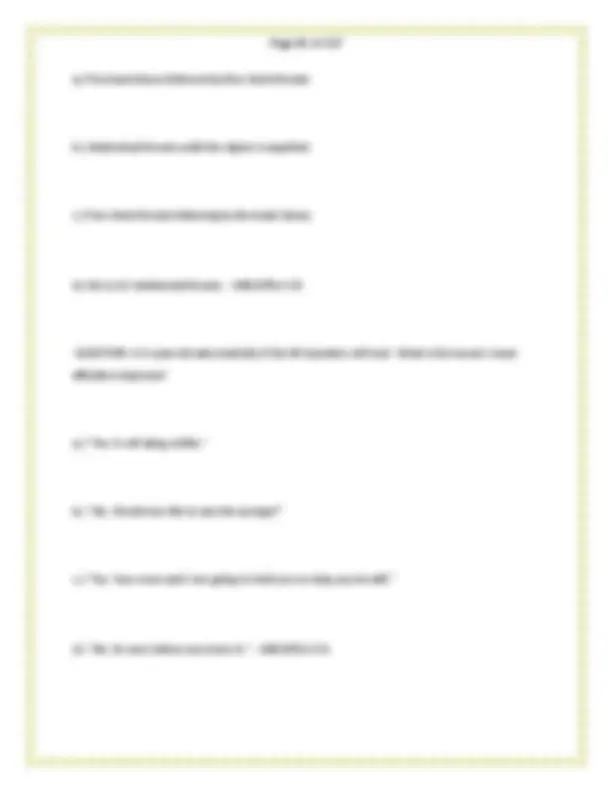
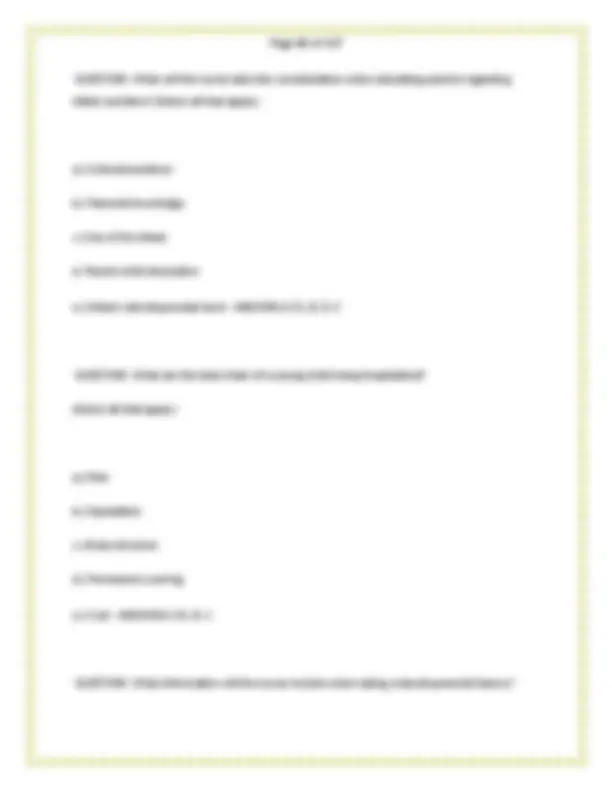
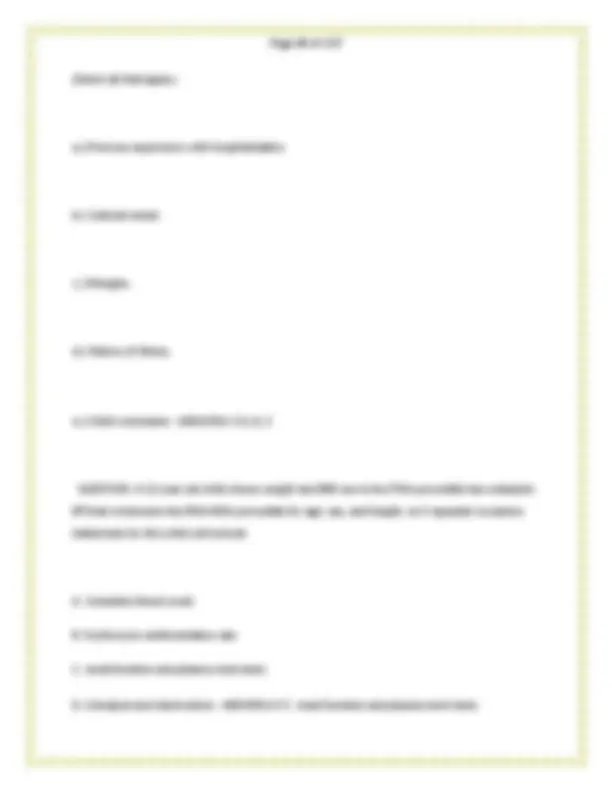
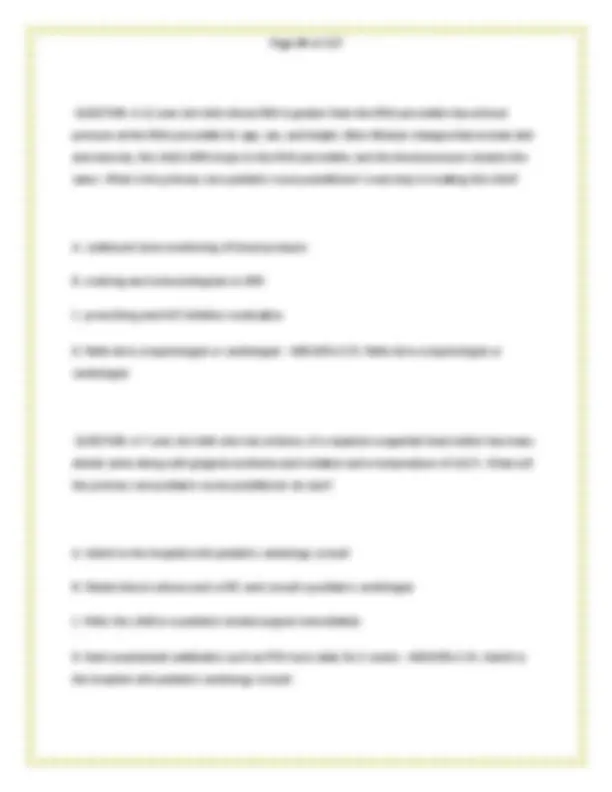
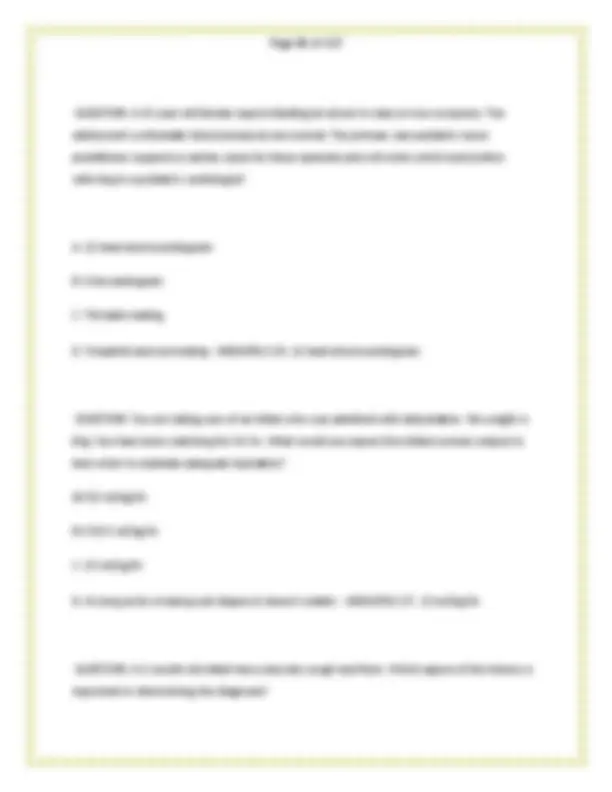
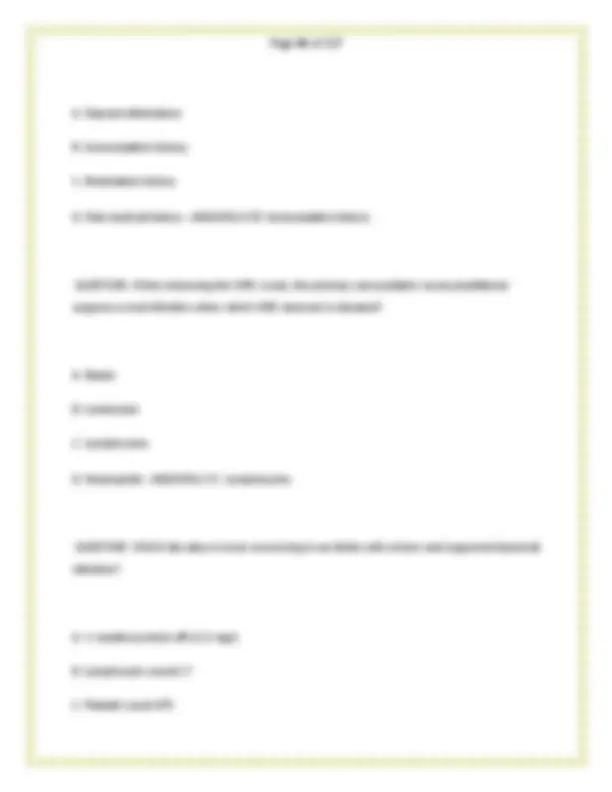
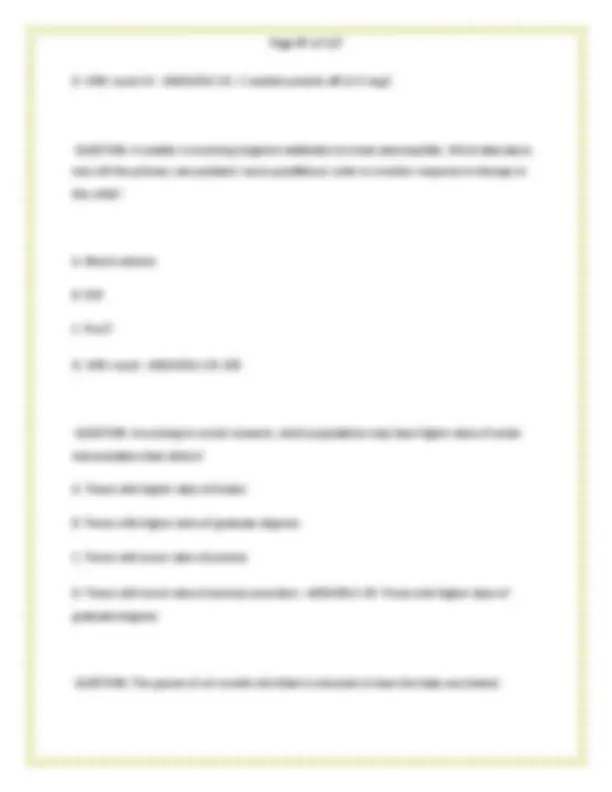
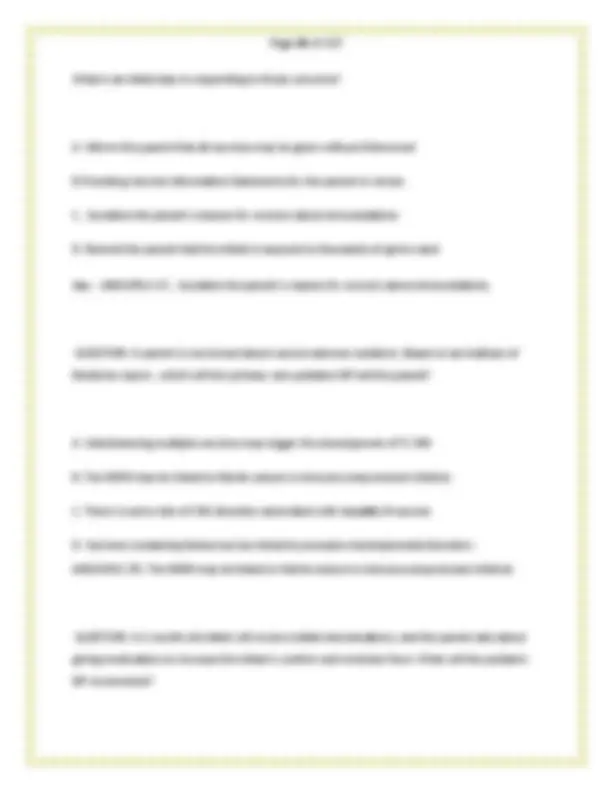
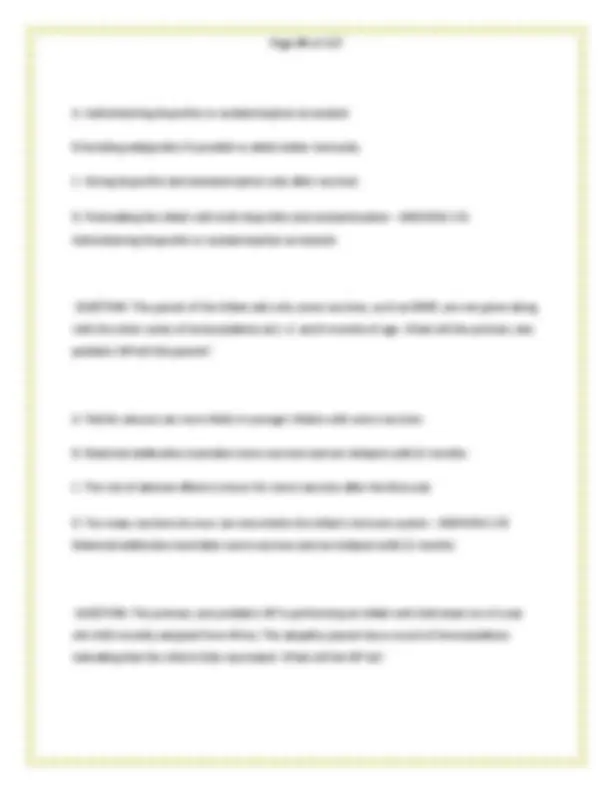
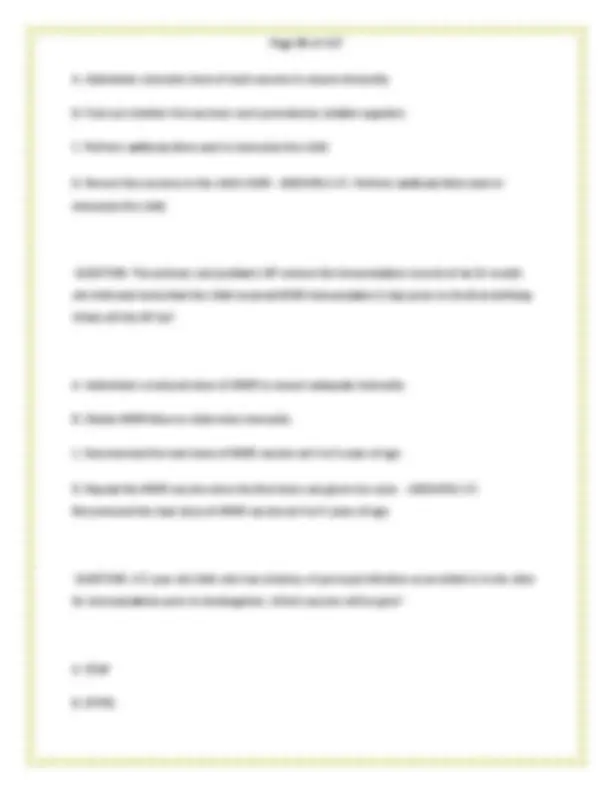
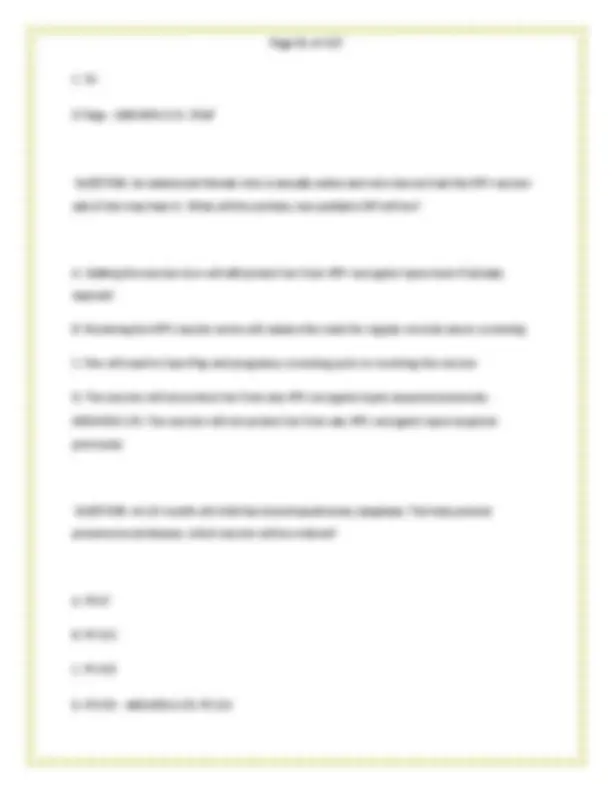
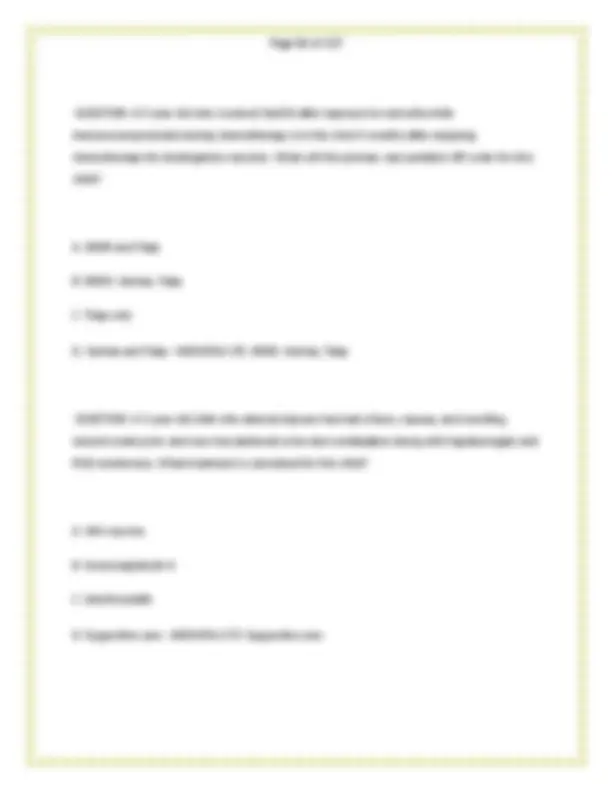
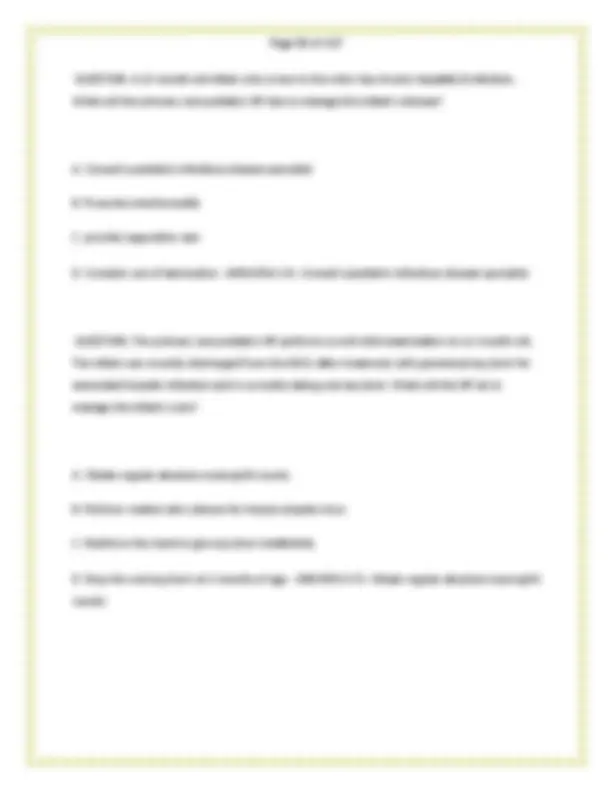
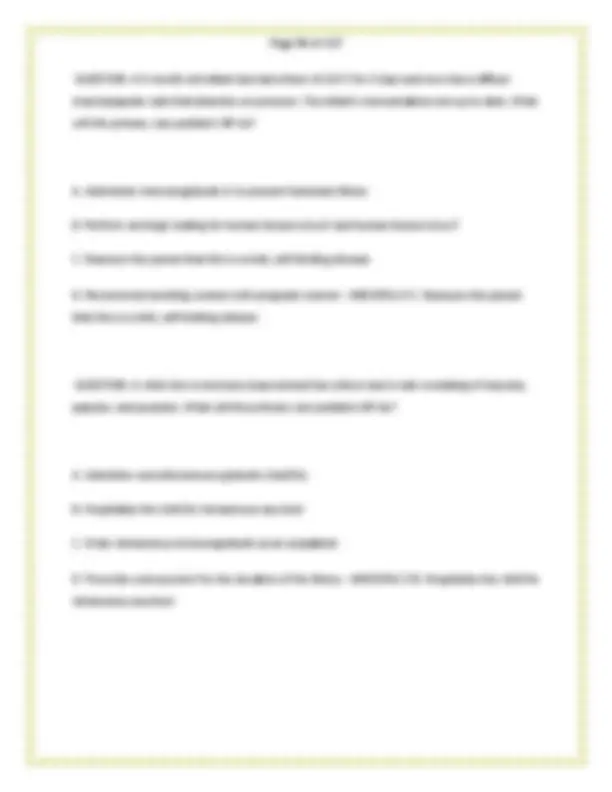
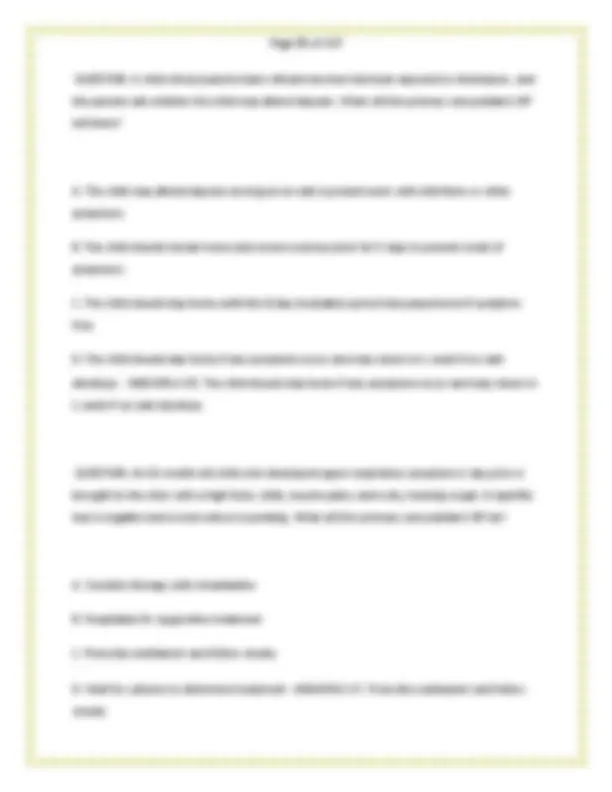
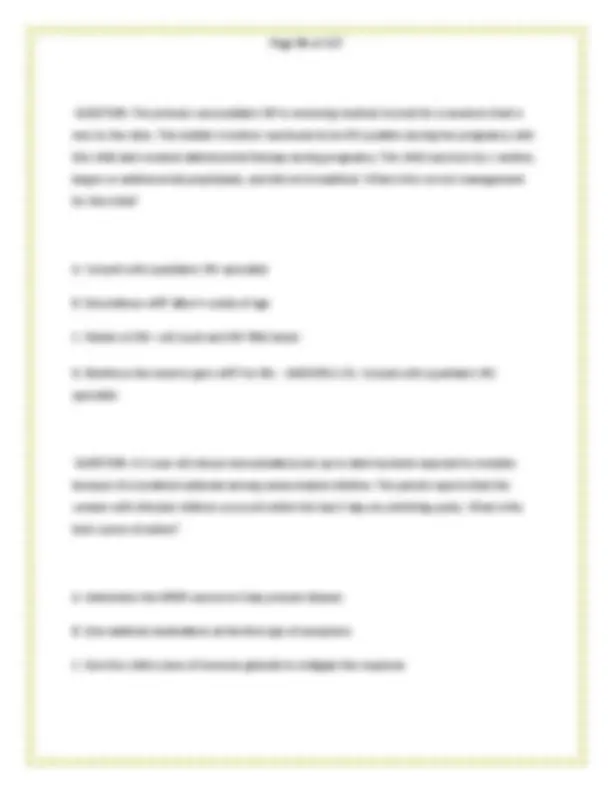
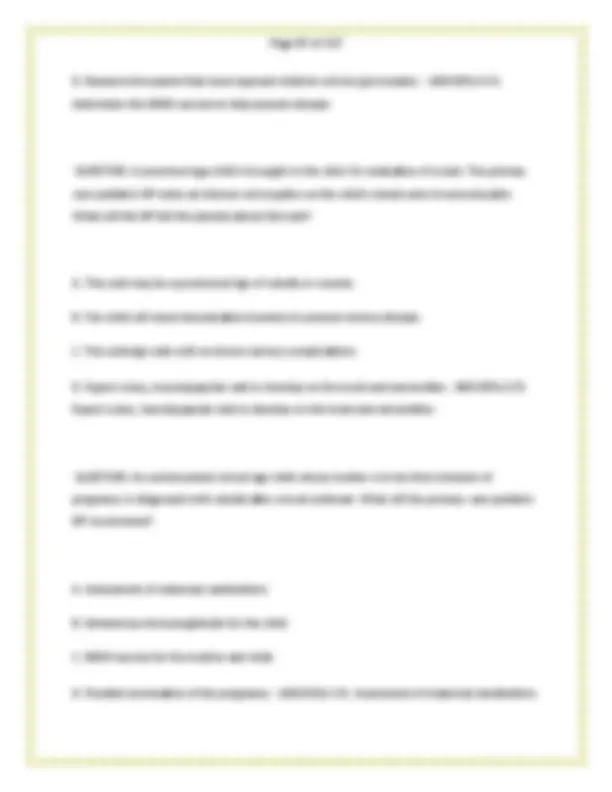
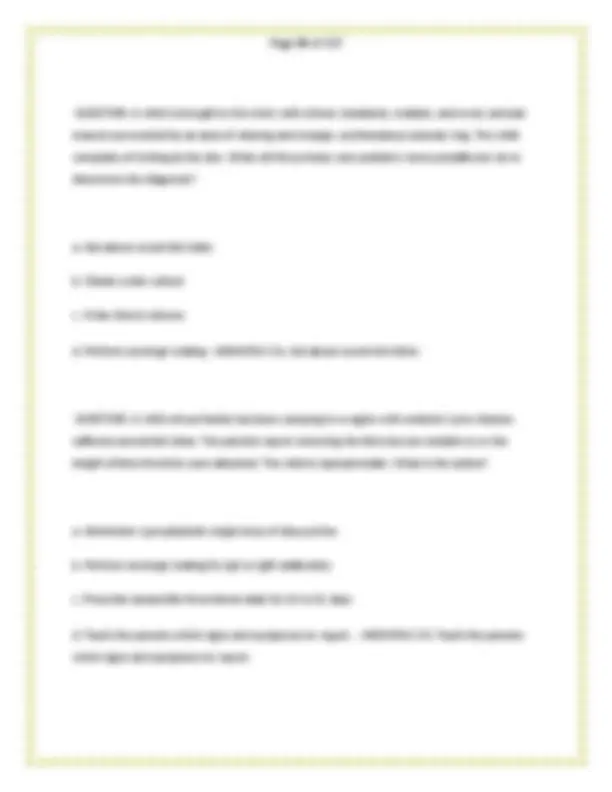
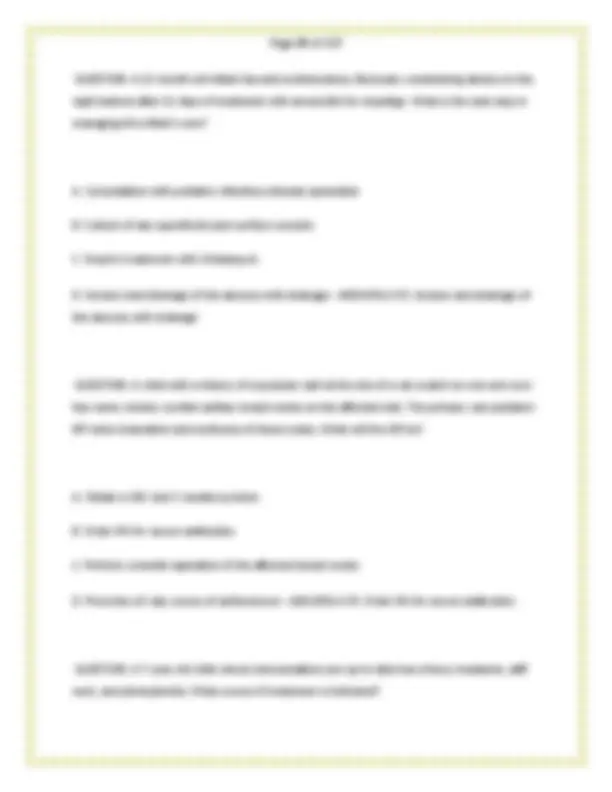
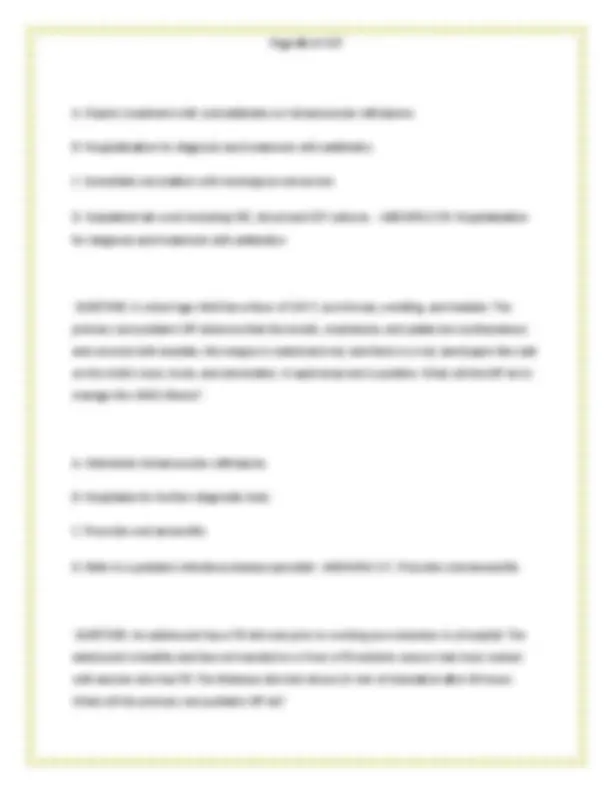
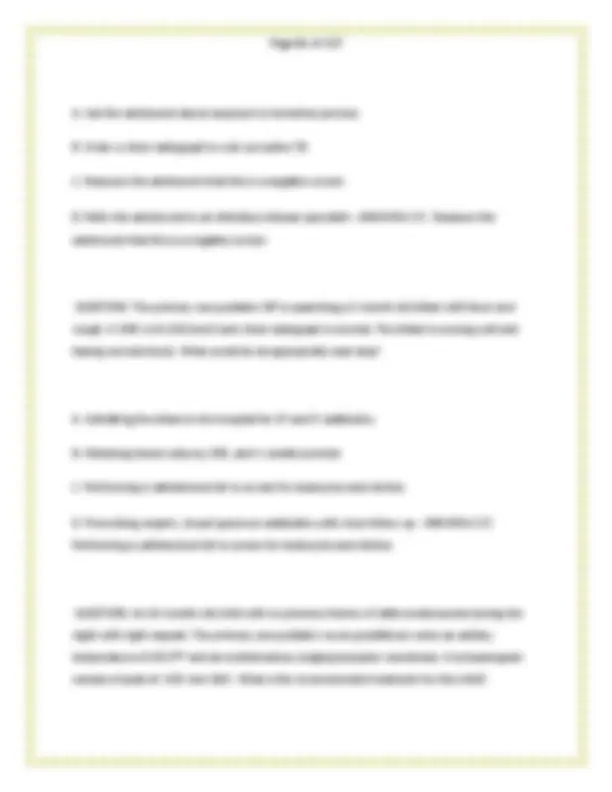
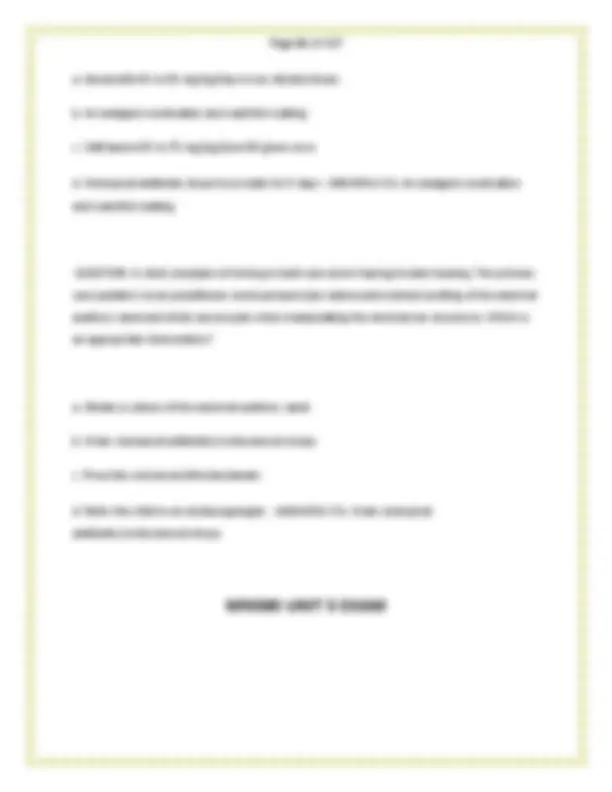
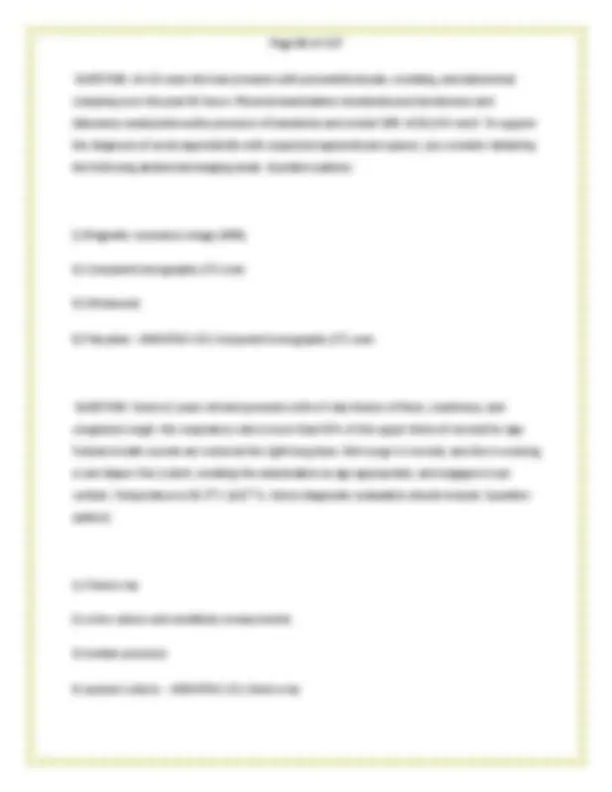
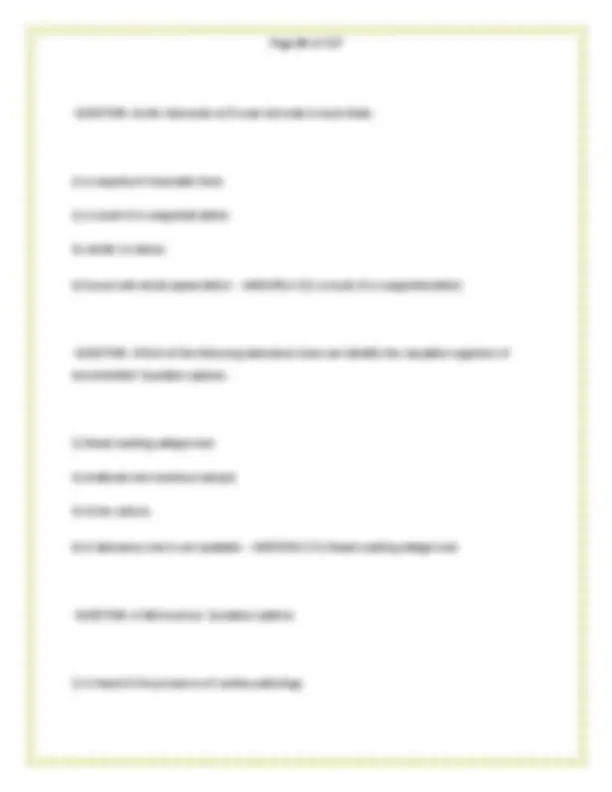
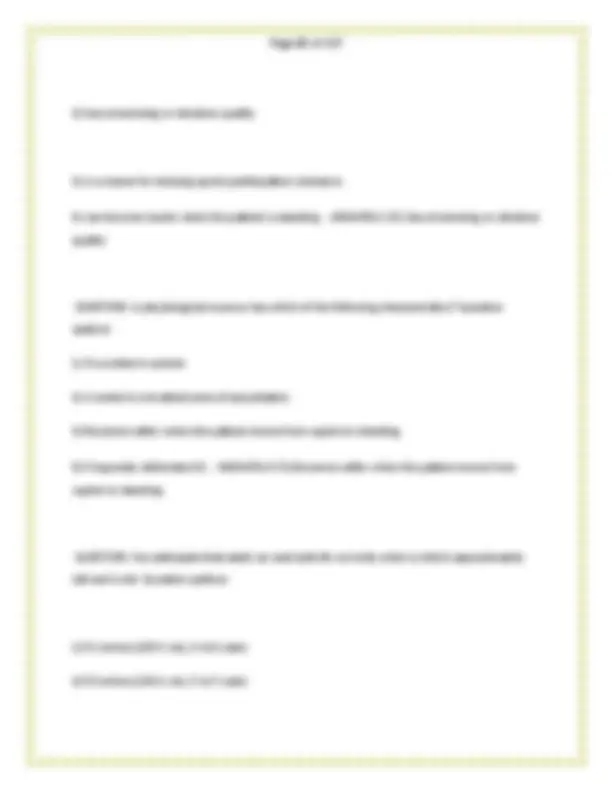
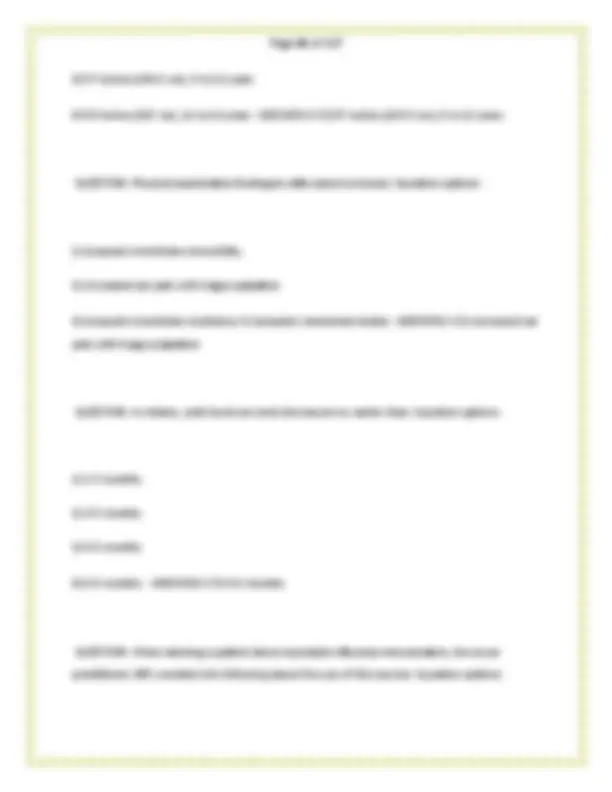
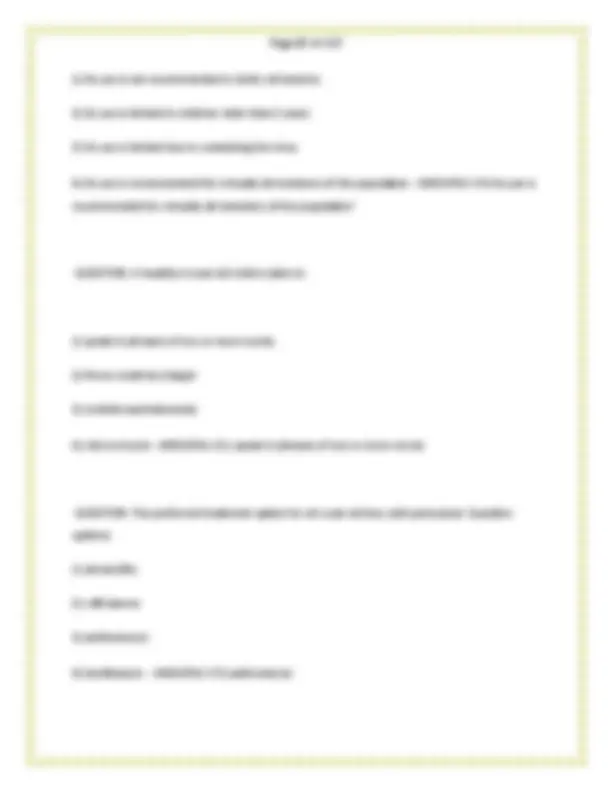
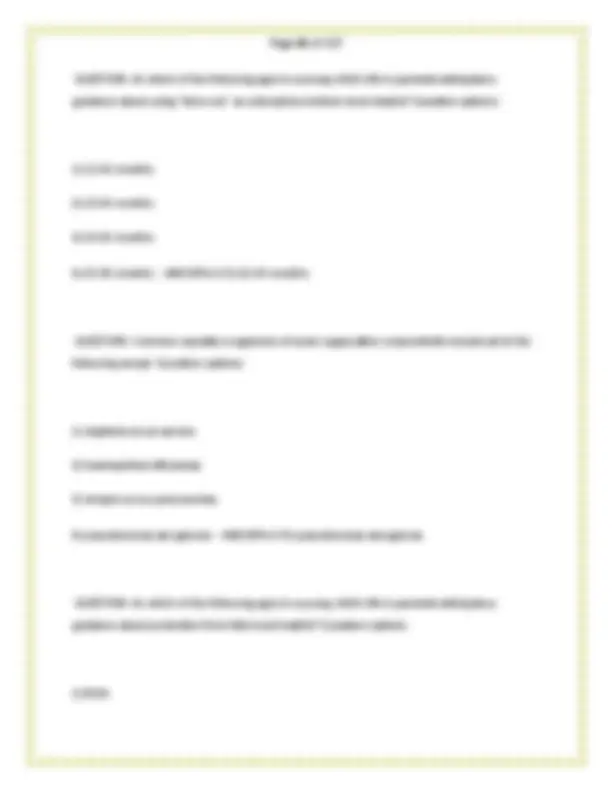
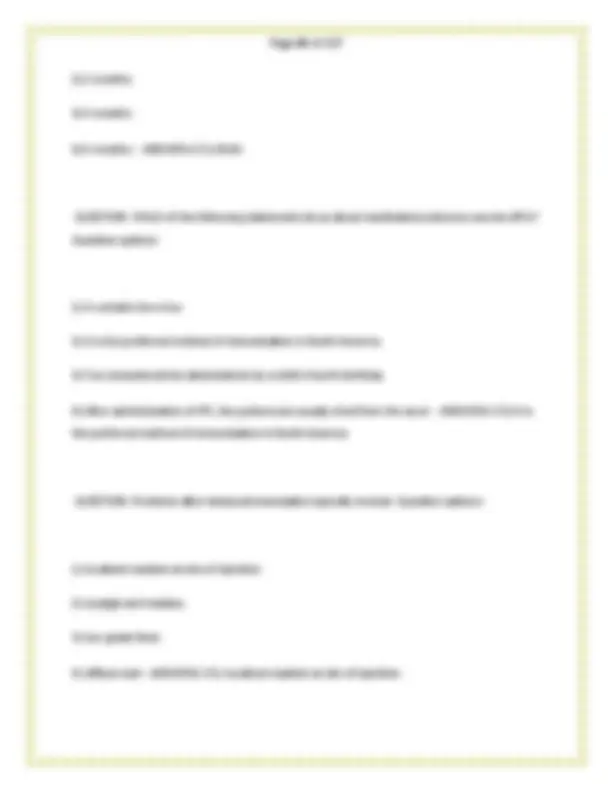
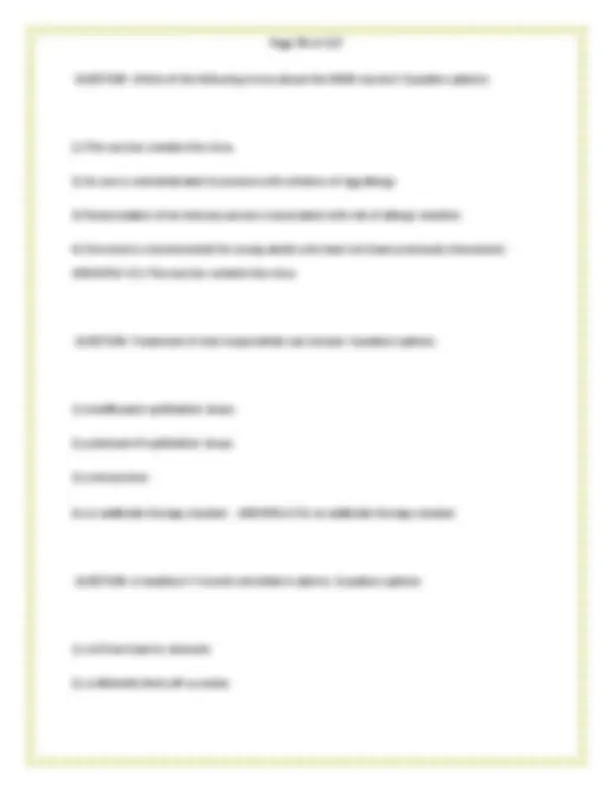
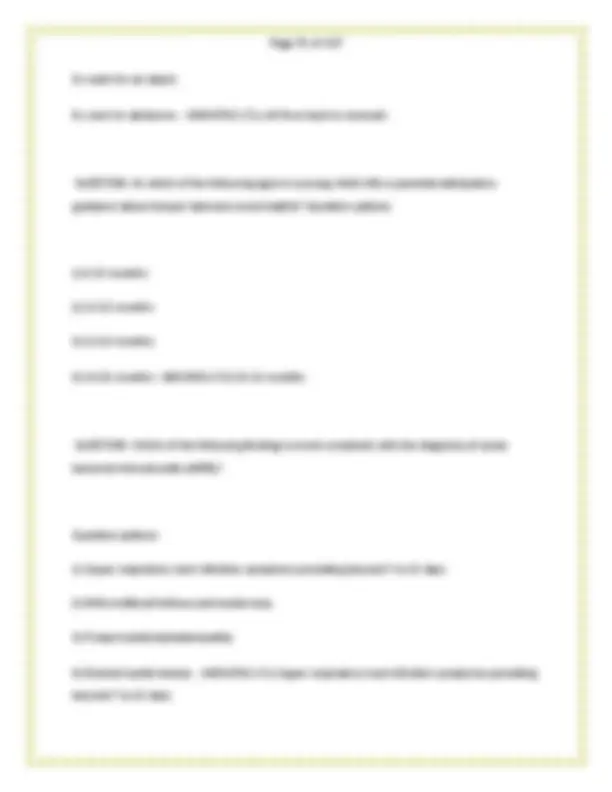
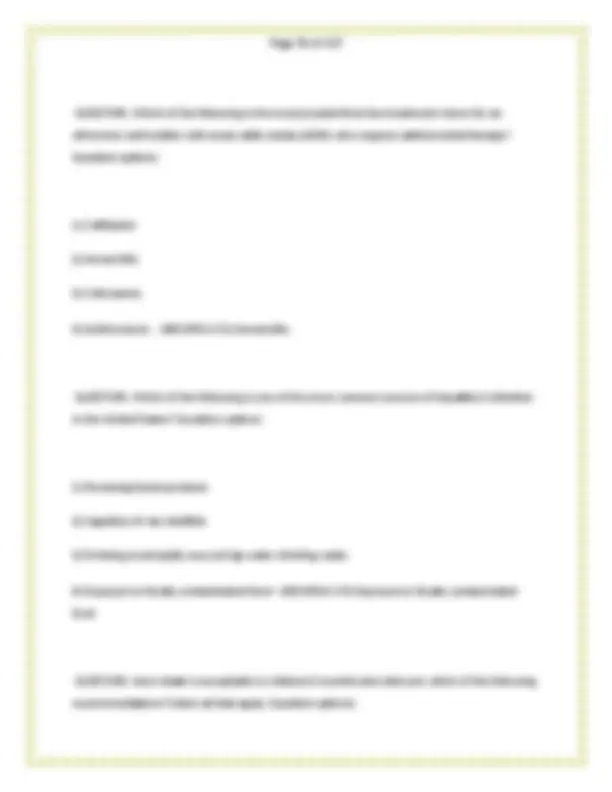
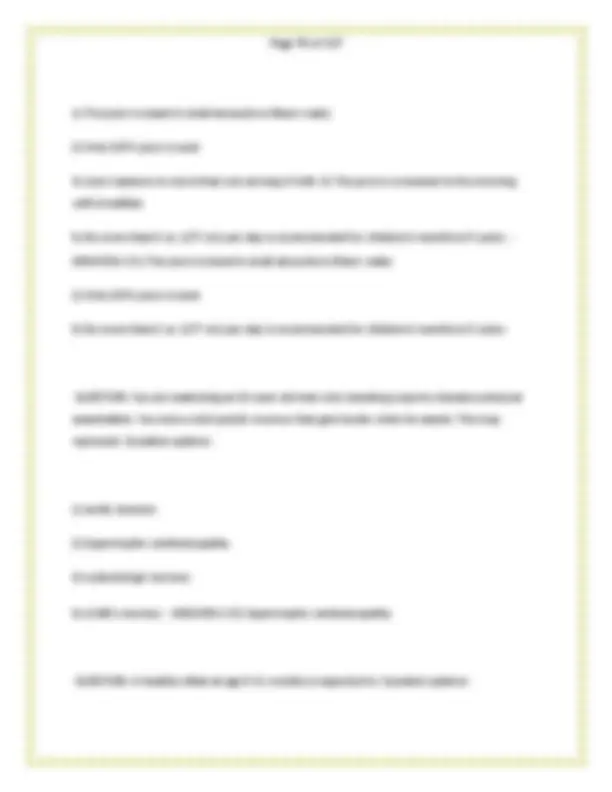
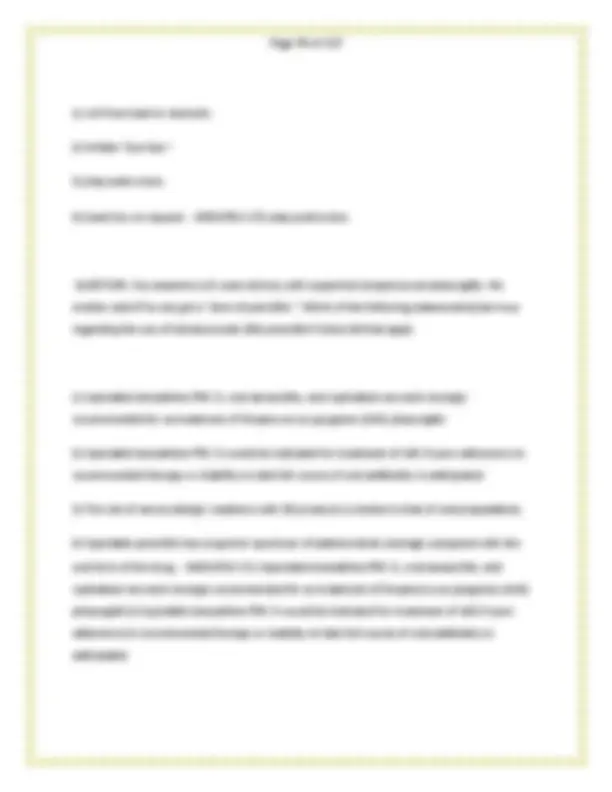
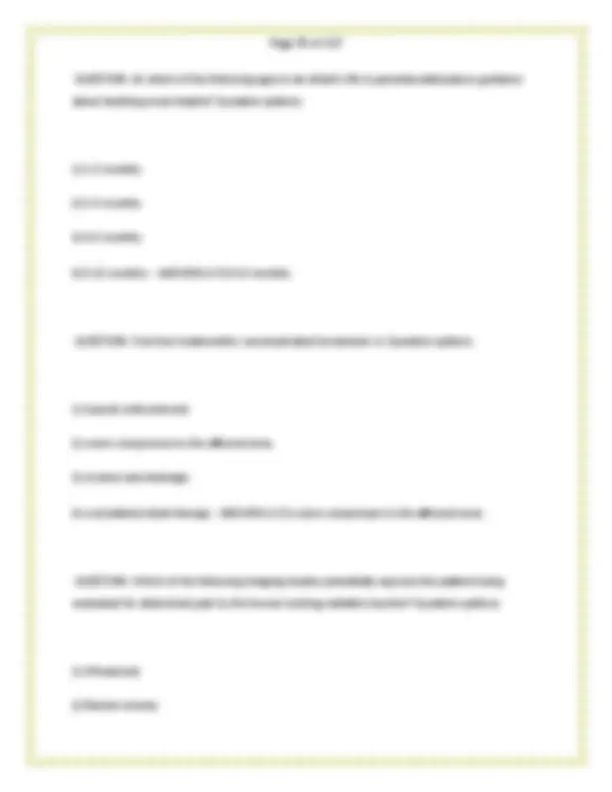
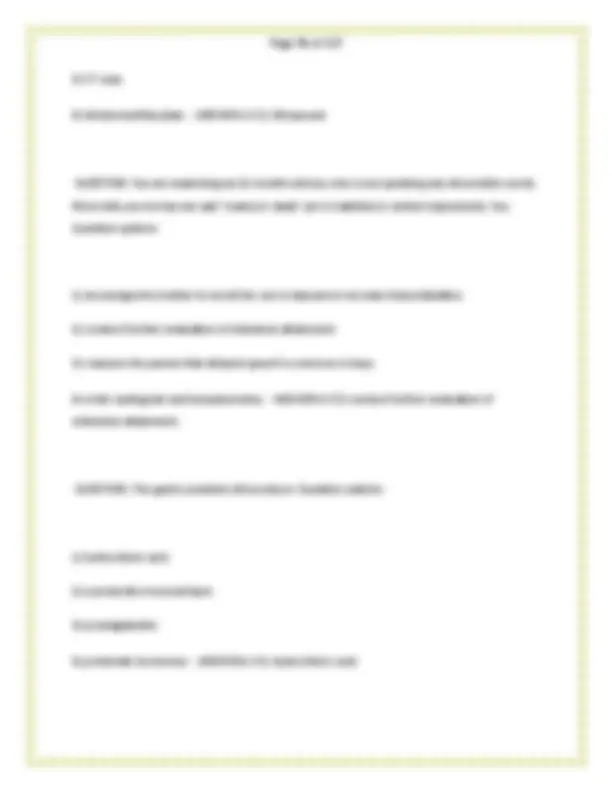
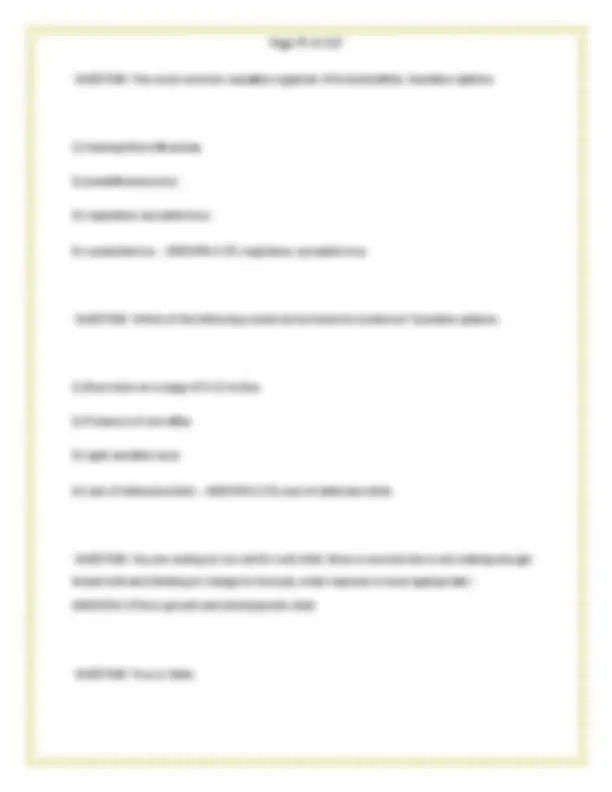
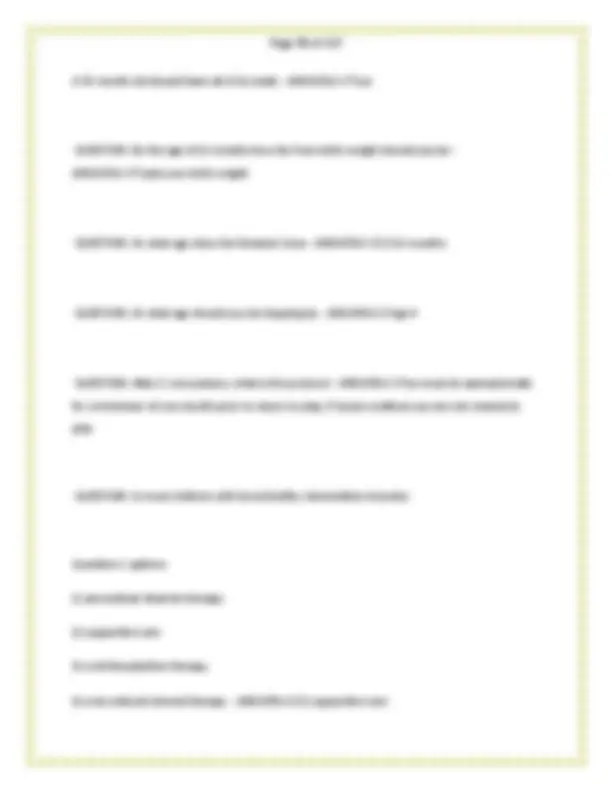
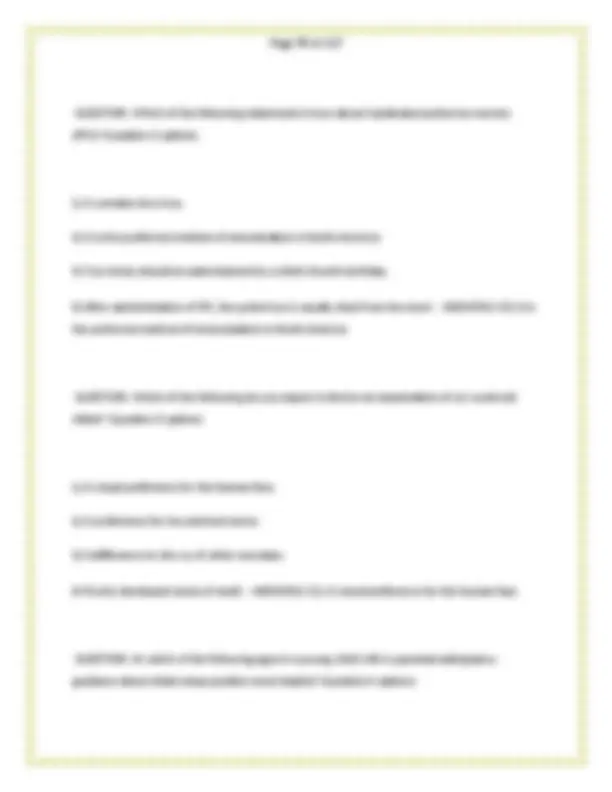
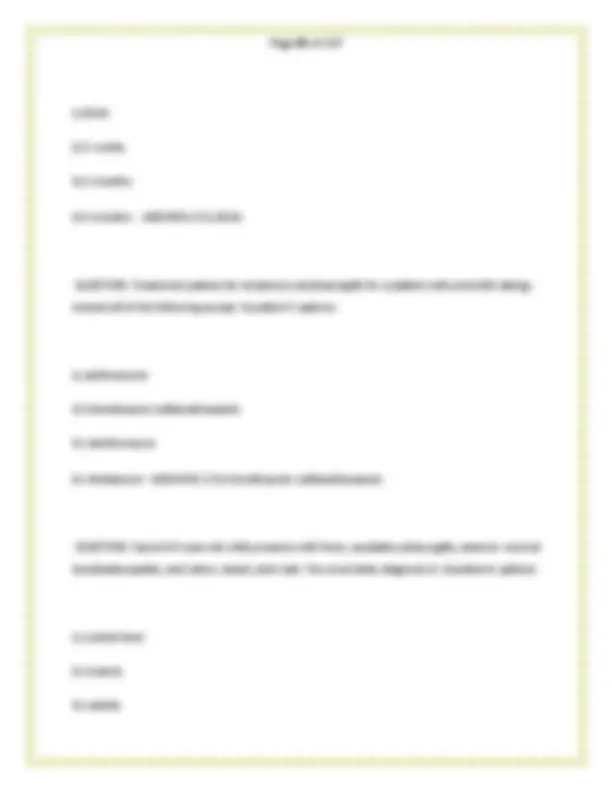
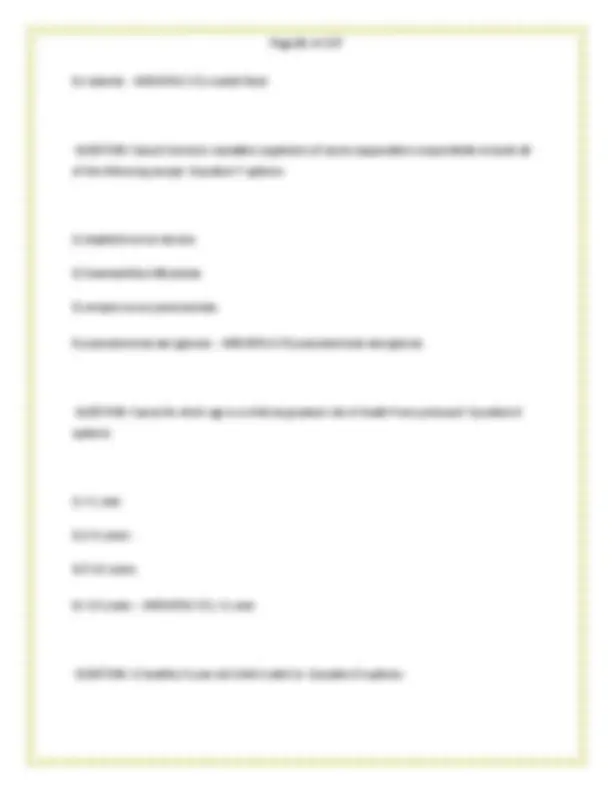
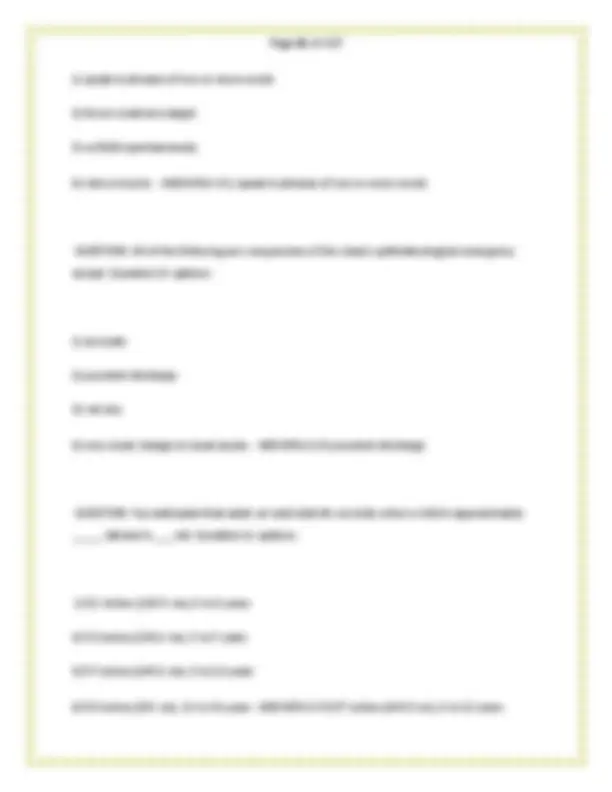
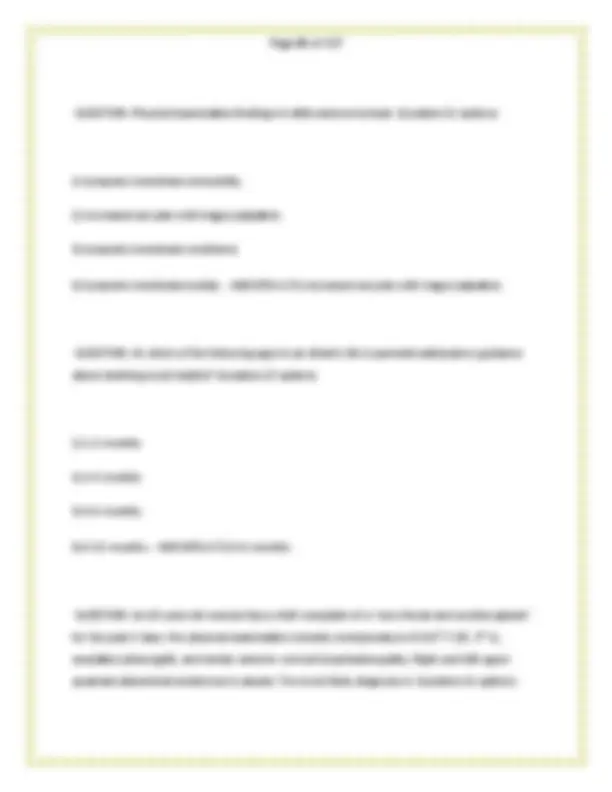
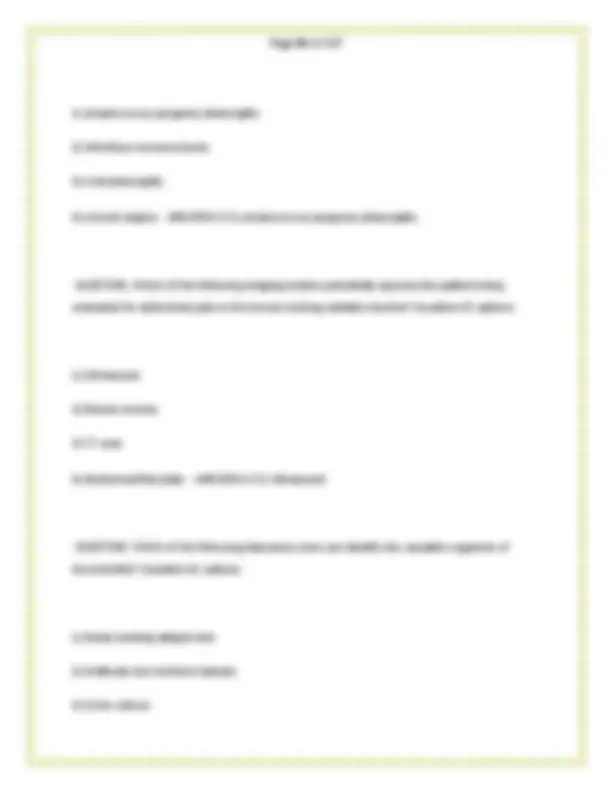
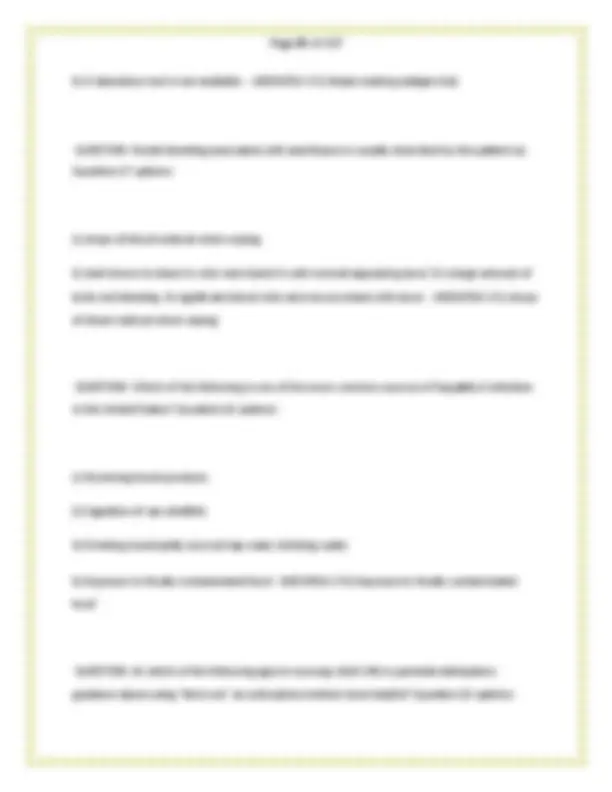
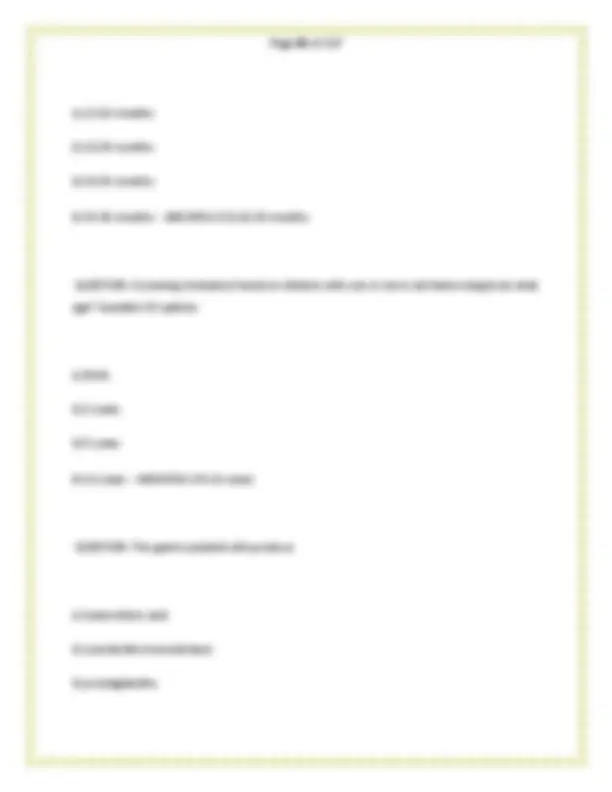
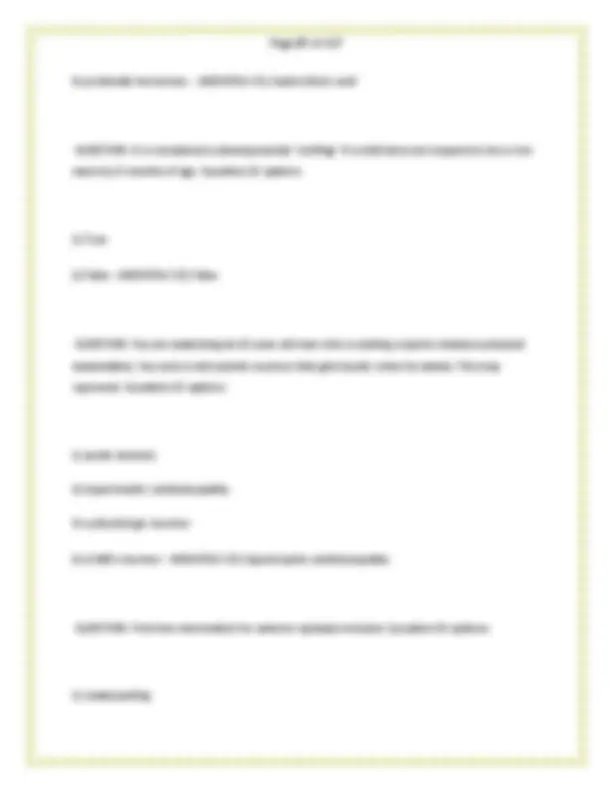
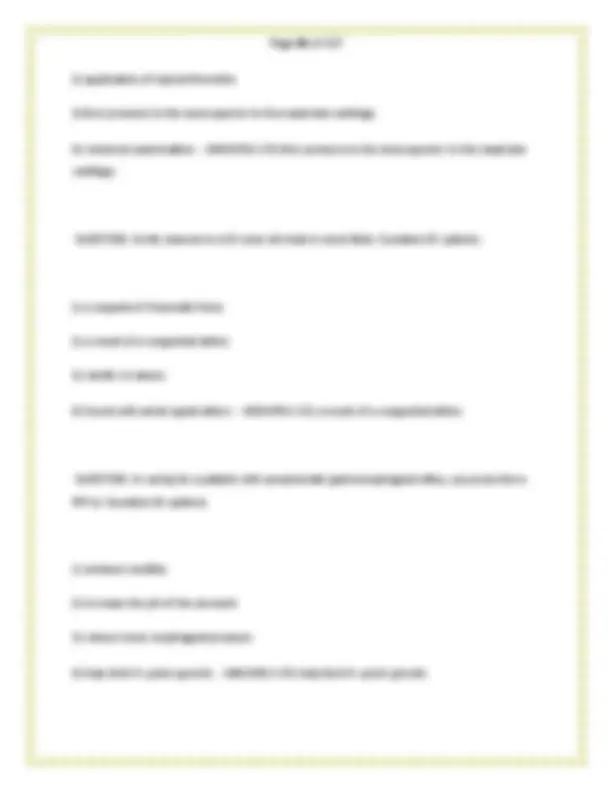
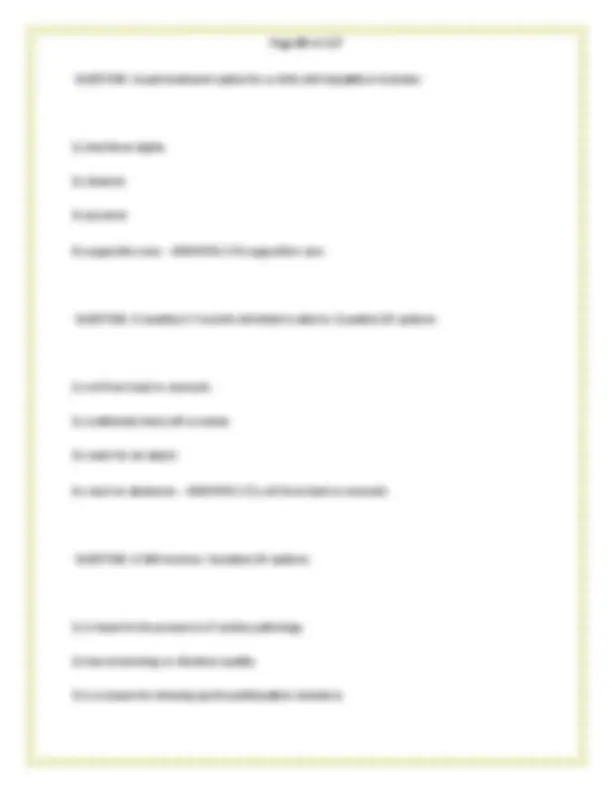
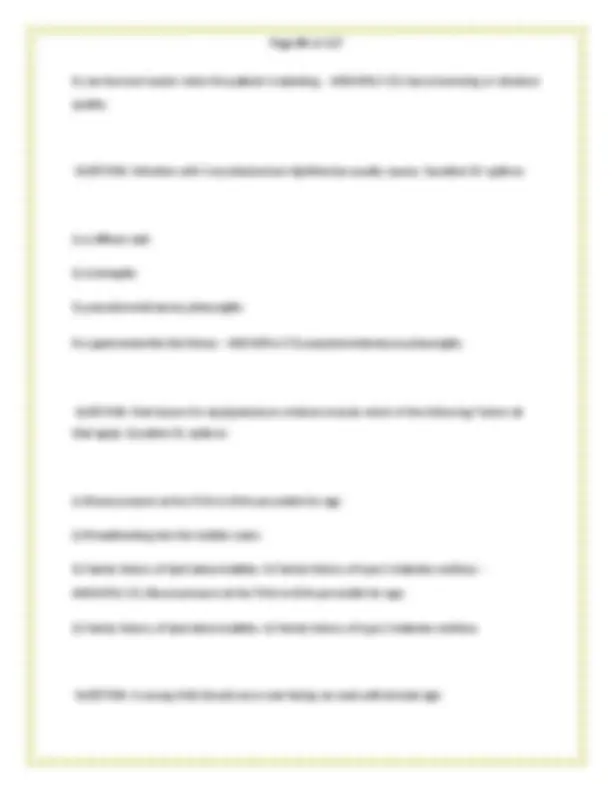
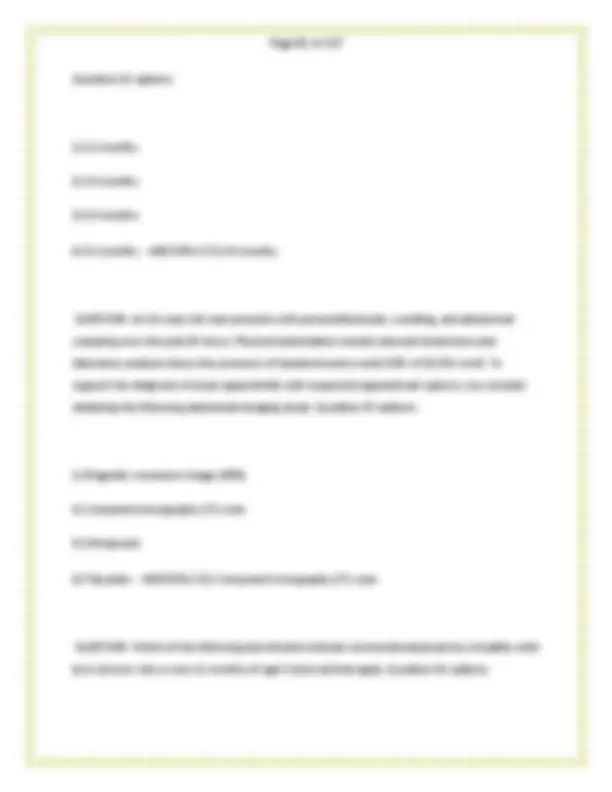
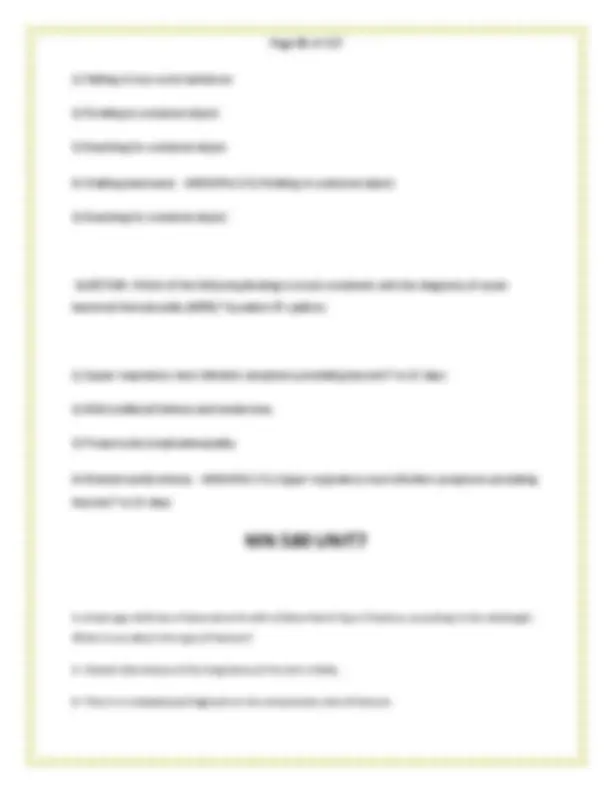
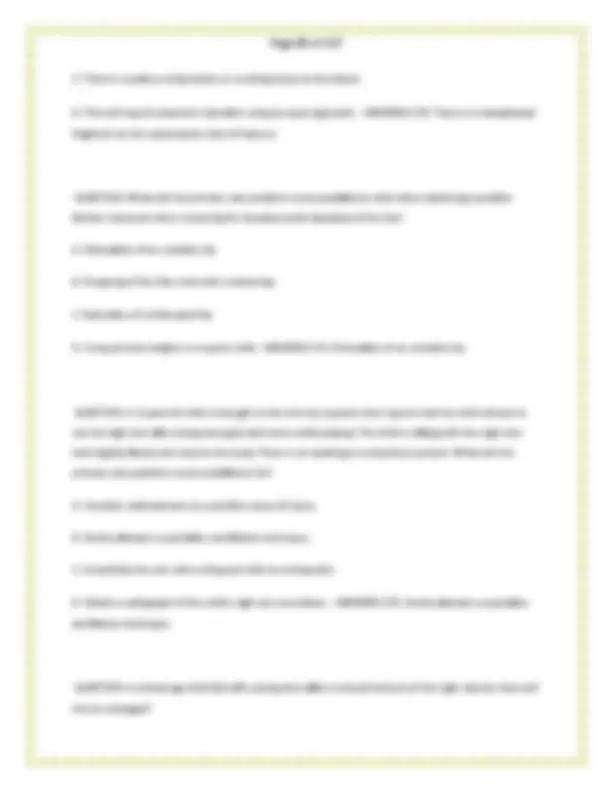
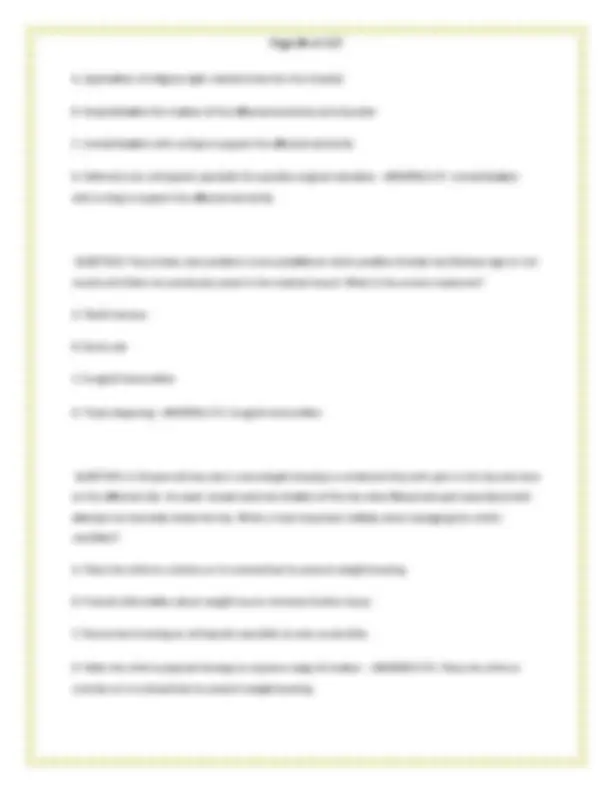
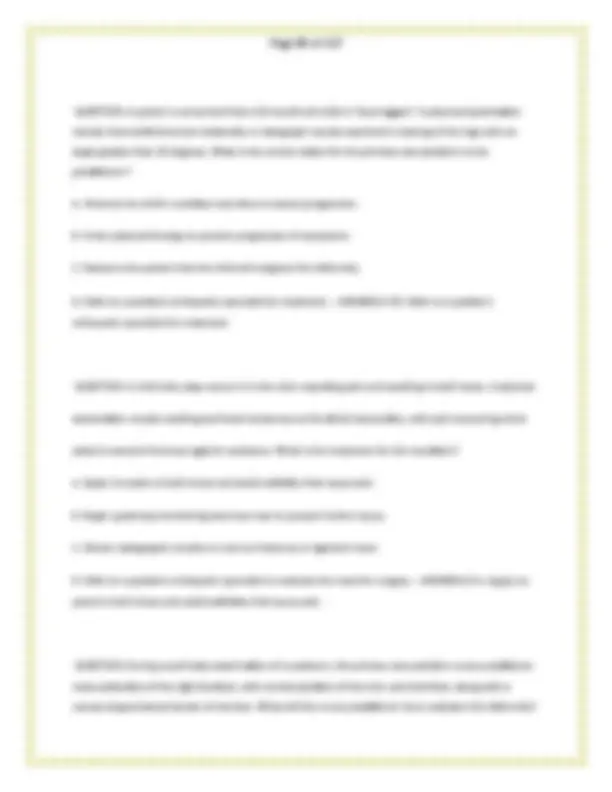
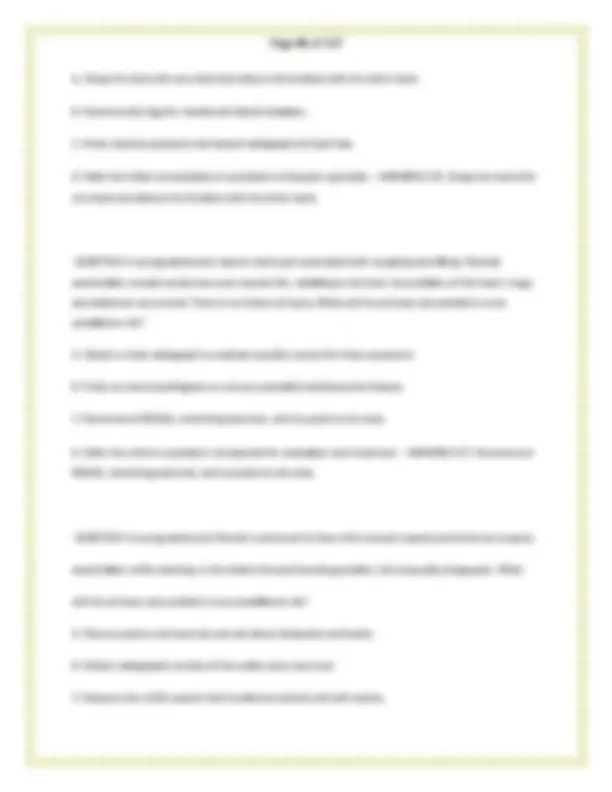
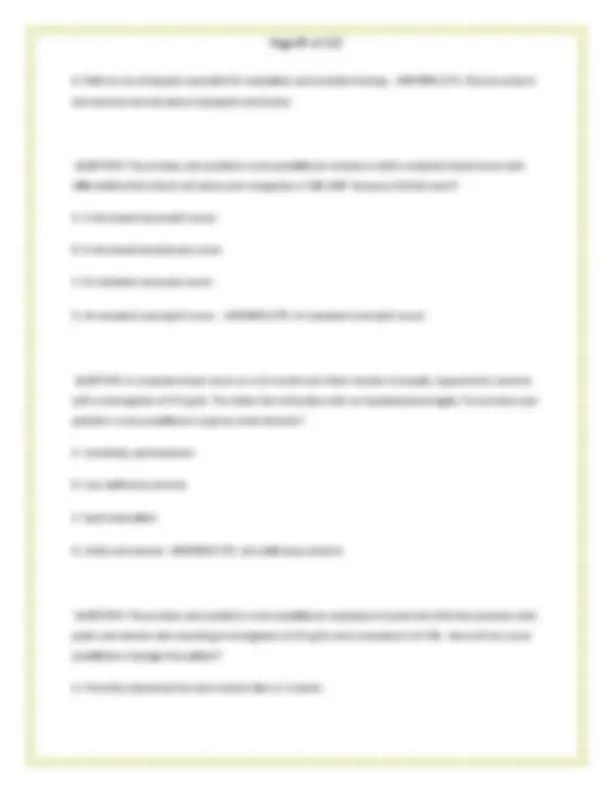
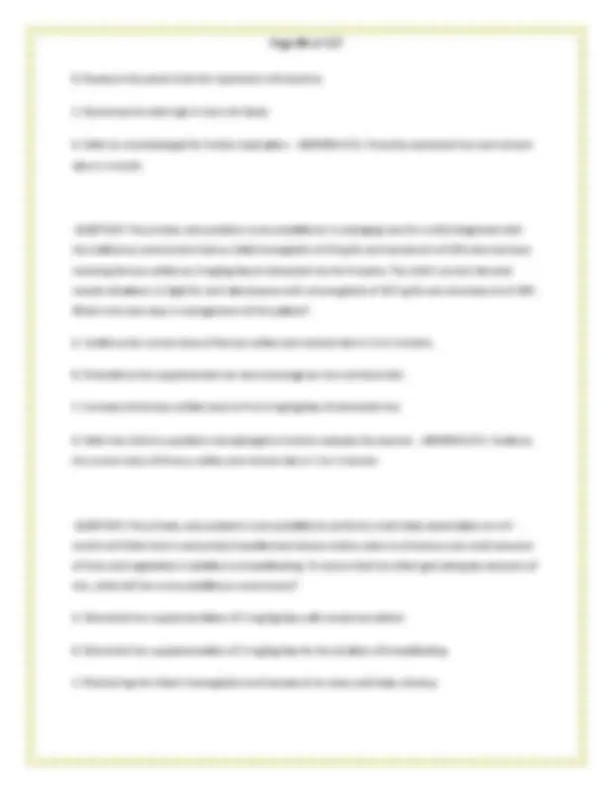
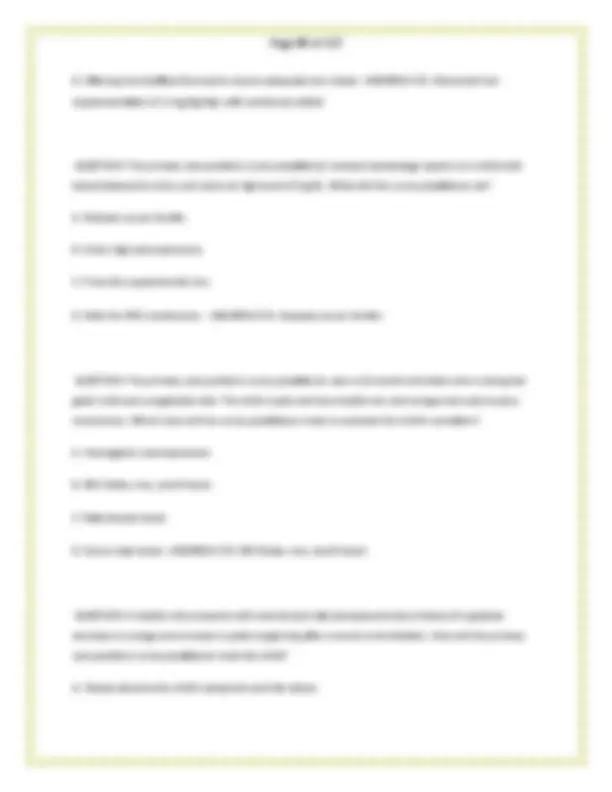
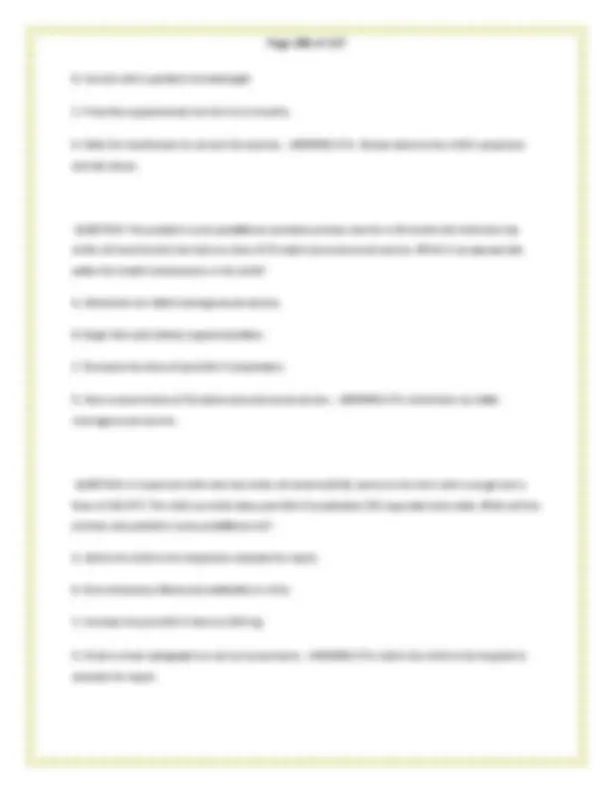


Study with the several resources on Docsity

Earn points by helping other students or get them with a premium plan


Prepare for your exams
Study with the several resources on Docsity

Earn points to download
Earn points by helping other students or get them with a premium plan
Community
Ask the community for help and clear up your study doubts
Discover the best universities in your country according to Docsity users
Free resources
Download our free guides on studying techniques, anxiety management strategies, and thesis advice from Docsity tutors
MN 580 MIDTERM AND FINAL EXAM LATEST VERSION THIS YEAR WITH 350 QUESTIONS AND WELL ELABORATED ANSWERS WITH JUST RELEASED .pdf
Typology: Exams
1 / 117

This page cannot be seen from the preview
Don't miss anything!





























































































QUESTION: The nurse will contribute which neonate characteristics noted in the first period of reactivity to sympathetic system changes? (Select all that apply.) a. Transient rales b. Tachycardia c. Presence of oral mucus d. Passage of meconium e. Alertness - ANSWER✔✔ANS: A, B, E The first period of reactivity includes sympathetic system changes, such as tachycardia, rapid respirations, transient rales, grunting, flaring and retractions, a falling body temperature, hypertonus, and alertness. Parasympathetic system changes during the first period of reactivity include the initiation of bowel sounds and the production of oral mucus. After an interval of sleep, the newborn enters the second period of reactivity. During this time, the oral mucus production again becomes evident, the heart rate becomes labile, the newborn becomes more responsive to endogenous and exogenous stimuli, and meconium is often passed. QUESTION: Which assessment factors are included in a 5-minute APGAR score? (Select all that apply.)
a. Heart rate b. Respiratory rate c. Skin color d. Muscle tone e. Crying - ANSWER✔✔ANS: A, B, C, D Heart and respiratory rates, skin color and muscle tone are assessed at both the 1 and 5 minute APGAR scoring. While crying has a positive affect on respirations, crying is not a focus of the assessment QUESTION: Which assessment findings suggest that the neonate is demonstrating stabilization of physiological functions? a. Temperature: 97.7° F b. Heart rate: 200 bpm c. Systolic pressure: 100 mm Hg d. Respiratory rate: 28 breaths/minute - ANSWER✔✔ANS: A Temperature is considered stable when between (97.7° to 99.3° F [36.5° to 37.4° C]) in open crib after birth. Heart rate is normally 100 to 190 bpm. Systolic blood pressures greater than 96 mm Hg are considered significant hypertension in the newborn. Unlabored respirations at a rate of 30 to 60 breaths/minute is considered normal.
QUESTION: Which interventions are recommendations suggested as preventive services for neonates?(Select all that apply.) a. Breastfeeding b. Screening neonates for sickle hemoglobinopathies c. Newborns screened for phenylketonuria (PKU) before being 24 hours old should be rescreened by 2 weeks old d. Screening for developmental hip dysplasia e. Screening for congenital hyperthyroidism within the first 4 days of life - ANSWER✔✔ANS: A, B, C, D Options related to breastfeeding and screening for sickle hemogplobinopathies, PKU, and hip dysplasia are recommended. Screening for hypothyroidism is recommended. QUESTION: When providing post delivery information regarding her infant, the nurse will confirm to the mother that which fetal cardiac structures have no function after her child is born? (Select all that apply.) a. Mitral valve b. Foramen ovale c. Cardiac septum d. Ductus arteriosus e. Pulmonary vein - ANSWER✔✔ANS: B, D The foramen ovale and ductus arteriosus are no longer necessary and close.
QUESTION: Apgar scores measure heart rate, respiratory rate, reflex irritability, color and a. Rigidity b. Muscle tone c. Birth weight d. Capillary refill - ANSWER✔✔ANS: B Muscle tone QUESTION: A mother on the postpartum unit asked to have her infant back from the nursery so that she can breastfeed. The nurse brings the newborn to the room and hands the baby to the mother. She asks the mother to let her know how long the baby feeds. What vital step did the nurse forget to take before giving the baby to the mother? a. The nurse should have made sure that the baby was latching correctly b. The nurse should have identified the baby's ID band with the mothers c. The nurse should have the mother speak with a lactation consultant d. The nurse should have asked the mother how long she planned to feed - ANSWER✔✔ANS: B The nurse should have identified the baby's ID band with the mothers QUESTION: Excessive heat loss results in which of these? a. RDS
c. Blood glucose d. PTT - ANSWER✔✔ANS: C Blood Glucose QUESTION: A pregnant woman with a history of a clotting disorder is required to self- administer heparin during her pregnancy. After delivery, the infant will be at greater risk for: a. Low blood sugar b. Decrease Vitamin K c. Increased Vitamin K d. High blood sugar - ANSWER✔✔ANS: 2 Decrease Vitamin K QUESTION: A part of injury prevention is making and keeping infant appointments. The required checkups and vaccinations are at: a. 3 months, 6 months, 9 months b. 2 months, 4 months, 6 months and 1 year c. 2 months, 4 months, 6 month, 9 months and 1 year d. 2 months, 4 months, 9 months and 1 year - ANSWER✔✔ANS: C 2 months, 4 months, 6 month, 9 months and 1 year
QUESTION: You are taking care of an infant who was admitted with dehydration. His weight is 6 kg. You have beenwatching his I & Os. What would you expect the infants urinary output to be in order to maintain adequate hydration? a. 0.52 ml/kg/hr b. 0.52.5 ml/kg/hr c. 13 ml/kg/hr d. As long as he is having wet diapers it doesnt matter - ANSWER✔✔ANS: C 13 ml/kg/hr QUESTION: A mother brings her newborn daughter to the ER with concerns that she is having vaginal bleeding. You know this is normal and called what? a. Pseudomenstruation b. Milia c. Vernix caseosa d. Toxicum - ANSWER✔✔ANS: A Pseudomenstruation QUESTION: While interviewing the mother of an infant, you note that the mother gets frustrated as she explains thather baby has been up all night crying at least 3 times a week for the last 2 weeks. She states that she has
QUESTION: The primary care pediatric nurse practitioner performs a well baby examination on a 7-day-old infant who is nursing well, according to the mother. The nurse practitioner notes that the infant weighed 3250 grams at birth and 2990 grams when discharged on the second day of life. The infant weighs 3080 grams at this visit. Which action is correct? a. Follow up at the 2-month checkup. b. Refer to a lactation consultant. c. Schedule a weight check in 1 week. d. Suggest supplementing with formula. - ANSWER✔✔C This infant lost about 8% of its birth weight, which is normal and, since discharge home, has gained at least 15 grams per day, which is also normal. The PNP should schedule a weight check in a week to make sure the infant regains its birth weight, since most should regain this in 10 to 14 days and since this loss of birth weight is at the high end of normal. It is not necessary to refer to a lactation consultant or supplement with formula, since the infant is gaining weight adequately. QUESTION: The parent of a newborn infant asks the primary care pediatric nurse practitioner when to intervene to help the infant's future intellectual growth. What will the nurse practitioner tell the parent? a. Cognitive learning begins during the toddler years. b. Intellectual growth begin when speech develops.
c. Language and literacy skills begin at birth. d. Preschool is an optimal time to begin general learning. - ANSWER✔✔c. Language and literacy skills begin at birth. General learning and acquisition of skills for later reading and writing begin at birth, not in kindergarten or first grade, and these skills grow with everyday loving interactions between infants and caregivers. Cognitive learning changes during toddler years but begins at birth. Intellectual growth is not tied to speech alone. QUESTION: The parent of a 10 yearold boy tells the primary care pediatric nurse practitioner that the child doesn't appear to have any interest in girls and spends most of his time with a couple of other boys. The parent is worried about the child's sexual identity. The nurse practitioner will tell the parent: A. children at this age who prefer interactions with same gender peers usually have a homosexual orientation. B. children experiment with sexuality at this age as a means of deciding later sexual orientation. C.this attachment to other same gender children is how the child learns to interact with others. D. to encourage mixed gender interactions in order to promote development of sexual values - ANSWER✔✔C.this attachment to other same gender children is how the child learns to interact with others. QUESTION: The parent of a 2weekold
and steroids. - ANSWER✔✔D Refer the infant to the emergency department for fluids, dextrose, and steroids. QUESTION: The parent of a 4-day-old infant tells the primary care pediatric nurse practitioner that the infant was diagnosed with hydronephrosis while in utero and asks what will be done. What will the nurse practitioner tell this parent? A.Renal function will be abnormal and will require lifetime treatment. B. Spontaneous resolution often occurs within 6 months to a yearof age. C. The affected kidney will be nonfunctionalbut the other kidney will compensate. D The infant will eventually require renal transplantation for that kidney. - ANSWER✔✔B. Spontaneous resolution often occurs within 6 months to a year of age. QUESTION: An initial key part of management of a child suspected of having an inborn error of metabolism is a. consulting a metabolic specialist b. obtaining a complete family history
.c. ordering metabolic screening tests. d. referring the family to a dietician. - ANSWER✔✔a. consulting a metabolic specialist QUESTION: The primary care pediatric nurse practitioner notes a musty odor when examining a newborn at a 2 week checkup. What will the nurse practitioner suspect? A.Galactosemia B. Glucose6phosphatase deficiency C. Phenylketonuria D. Urea cycle disorder - ANSWER✔✔C. Phenylketonuria QUESTION: A 16-year-old adolescent female whose BMI is at the 90th percentile reports irregular periods. The primary care pediatric nurse practitioner notes widespread acne on her face and back and an abnormal distribution of facial hair. The nurse practitioner will evaluate her further based on a suspicion of which diagnosis? A. Dyslipidemia B. Hypothyroidism C. Nonalcoholic steatohepatitis D. Polycystic ovary syndrome - ANSWER✔✔D. Polycystic ovary syndrome
A Congenital adrenal hyperplasia causing breast development B. Precocious puberty needing endocrinology management C. Premature adrenarche which will lead to pubic hair onset D. Premature thelarche which will resolve over time - ANSWER✔✔D. Premature thelarche which will resolve over time QUESTION: Select the statement that best describes the thelarche stage of puberty in females.
D. provide adequate protein to meet daily needs - ANSWER✔✔C. may be deficient in essential nutrients. QUESTION: A school age child has recurrent diarrhea with foul smelling stools, excessive flatus, abdominal distension, and failure to thrive. A 2week lactose free trial failed to reduce symptoms. What is the next step in diagnosing this condition? A. Lactose hydrogen breath test B. Serologic testing for celiac disease C. Stool for ova and parasites D. Sweat chloride test for cystic fibrosis - ANSWER✔✔B. Serologic testing for celiac disease QUESTION: Cyclic vomiting may:
C. Reassure the parent that this is a normal exam. D. Refer the child to an otolaryngologist for followup - ANSWER✔✔A. Order ototopical antibiotic/corticosteroid drops QUESTION: The primary care pediatric nurse practitioner notes a small, round objectin a child's external auditory canal, near the tympanic membrane. The child's parent thinks it is probably a dried pea. What will the nurse practitioner do to remove this object? A. Irrigate the external auditory canal to flush out the object. B.Refer the child to an otolaryngologist for removal. C. Remove the object with a wire loop curette. D. Use a bayonet forceps to grasp and remove the object. - ANSWER✔✔B.Refer the child to an otolaryngologist for removal. QUESTION: A 3-year-old child has had one episode of acute otitis media 3 weeks prior with abnormal tympanogram just after treatment with amoxicillin. In the clinic today, the child has a type B tympanogram, a temperature of 102.5°F, and a bulging tympanic membrane. What will the primary care pediatric nurse practitioner order? A. A referral for tympanocentesis B. Amoxicillin twice daily C. Amoxicillin clavulanate twice daily
D. Intramuscular ceftriaxone - ANSWER✔✔C. Amoxicillinclavulanate twice daily QUESTION: The primary care pediatric nurse practitioner performs a well child examination on a 9monthold infant who has a history of prematurity at 28 weeks' gestation. The infant was treated for retinopathy of prematurity (ROP) and all symptomshave resolved. When will the infant need an ophthalmologic exam? A. At 12 months of age B At 24 months of age C. At 48 months of age D. At 60 months of age - ANSWER✔✔A. At 12 months of age QUESTION: An adolescent takes ibuprofen, acetaminophen, and a tricyclic antidepressant (TCA) to treat phantom limb pain and reports that the medications are no longer effective. What will the primary care pediatric nurse practitioner do? A. Change the TCA to a selective serotonin reuptake inhibitor. B. Evaluate the adolescent for drug seeking behavior. C. Increase the TCA dose and reevaluate in 2 to 3 weeks.